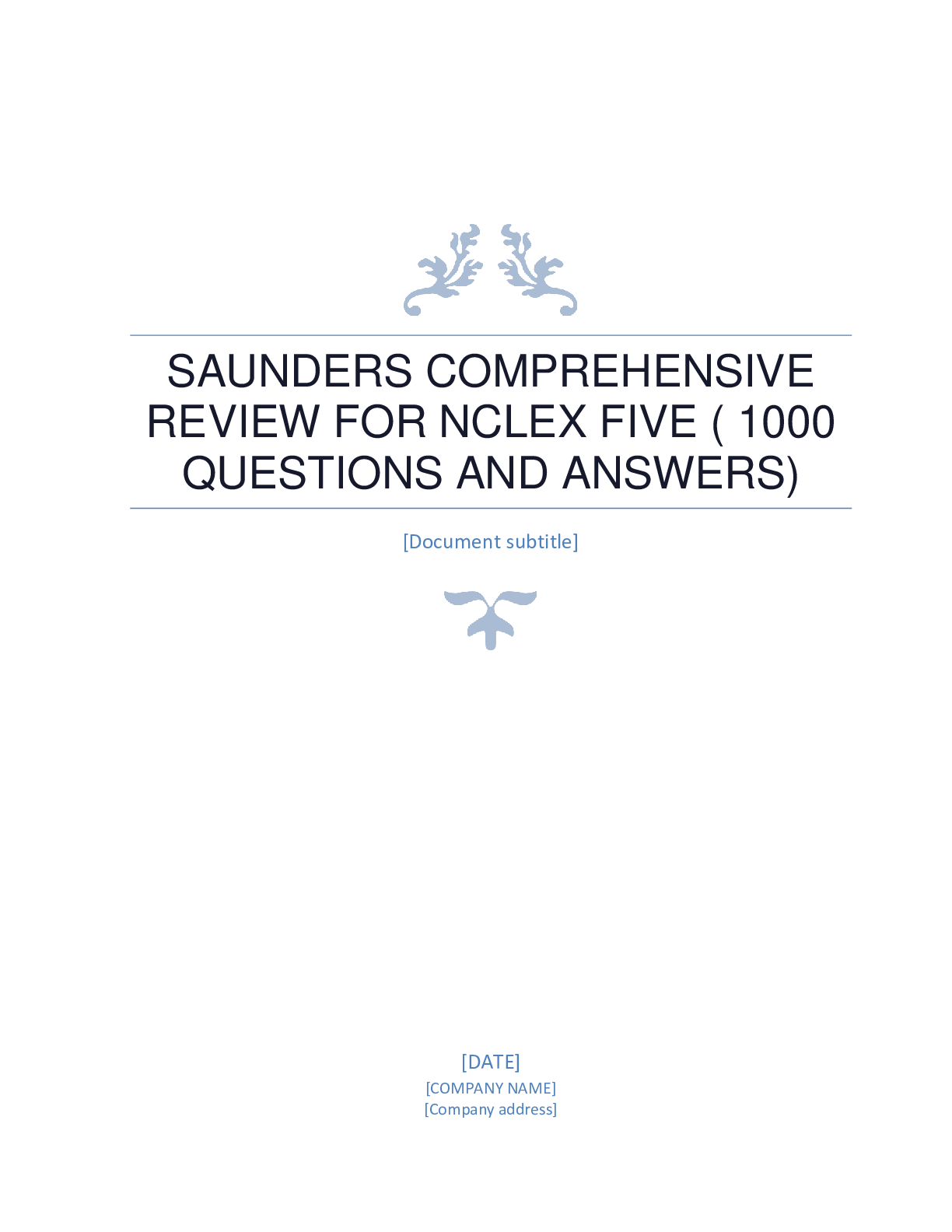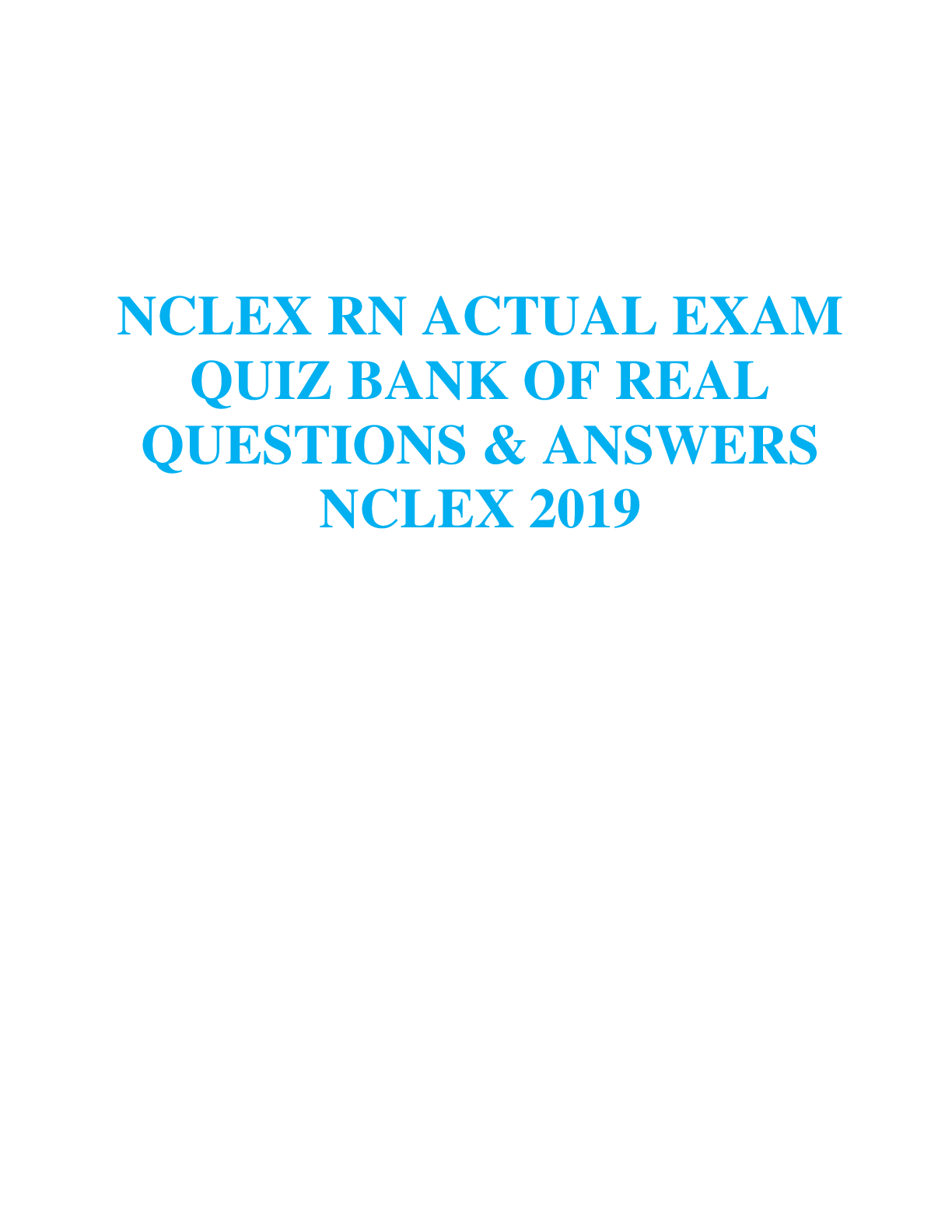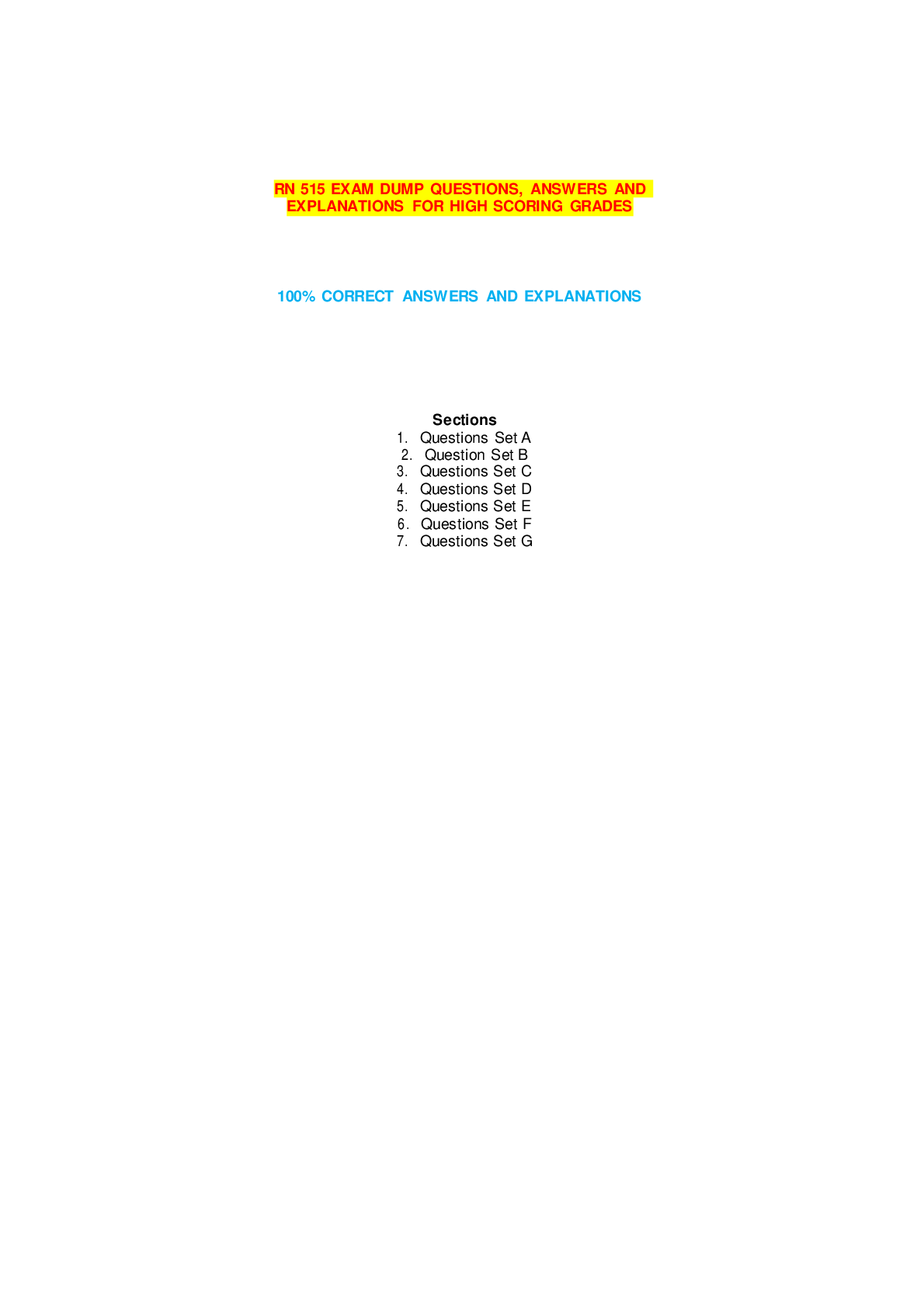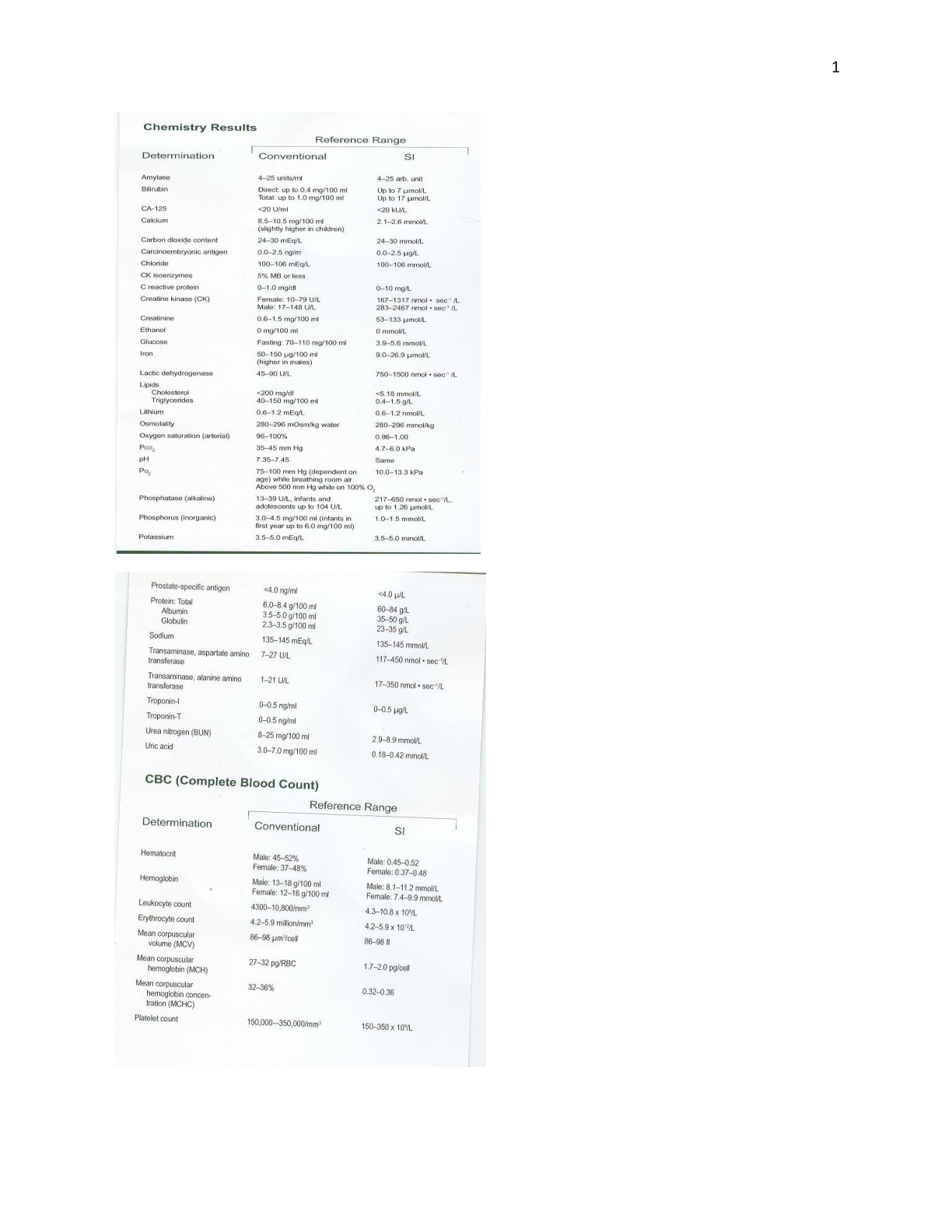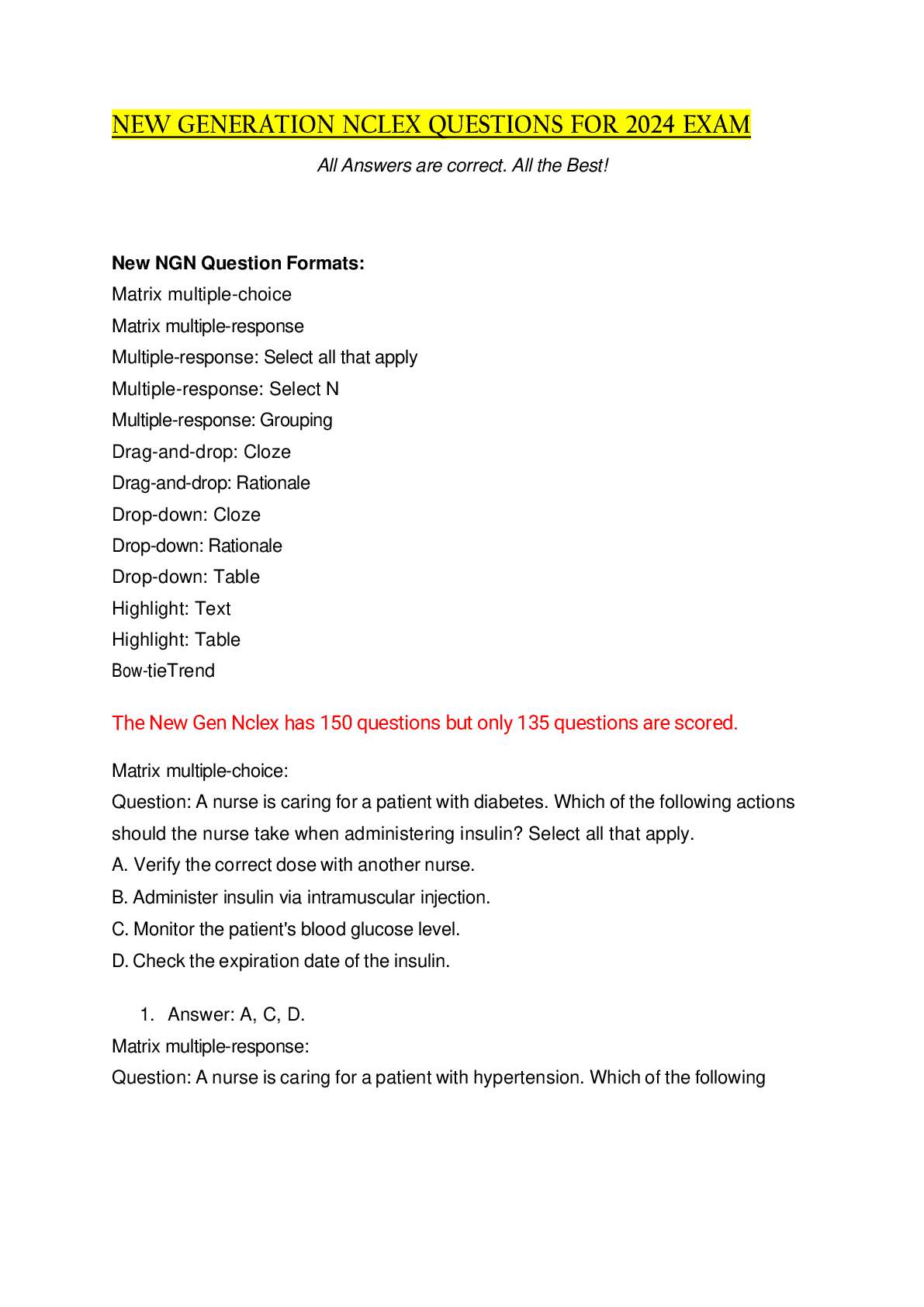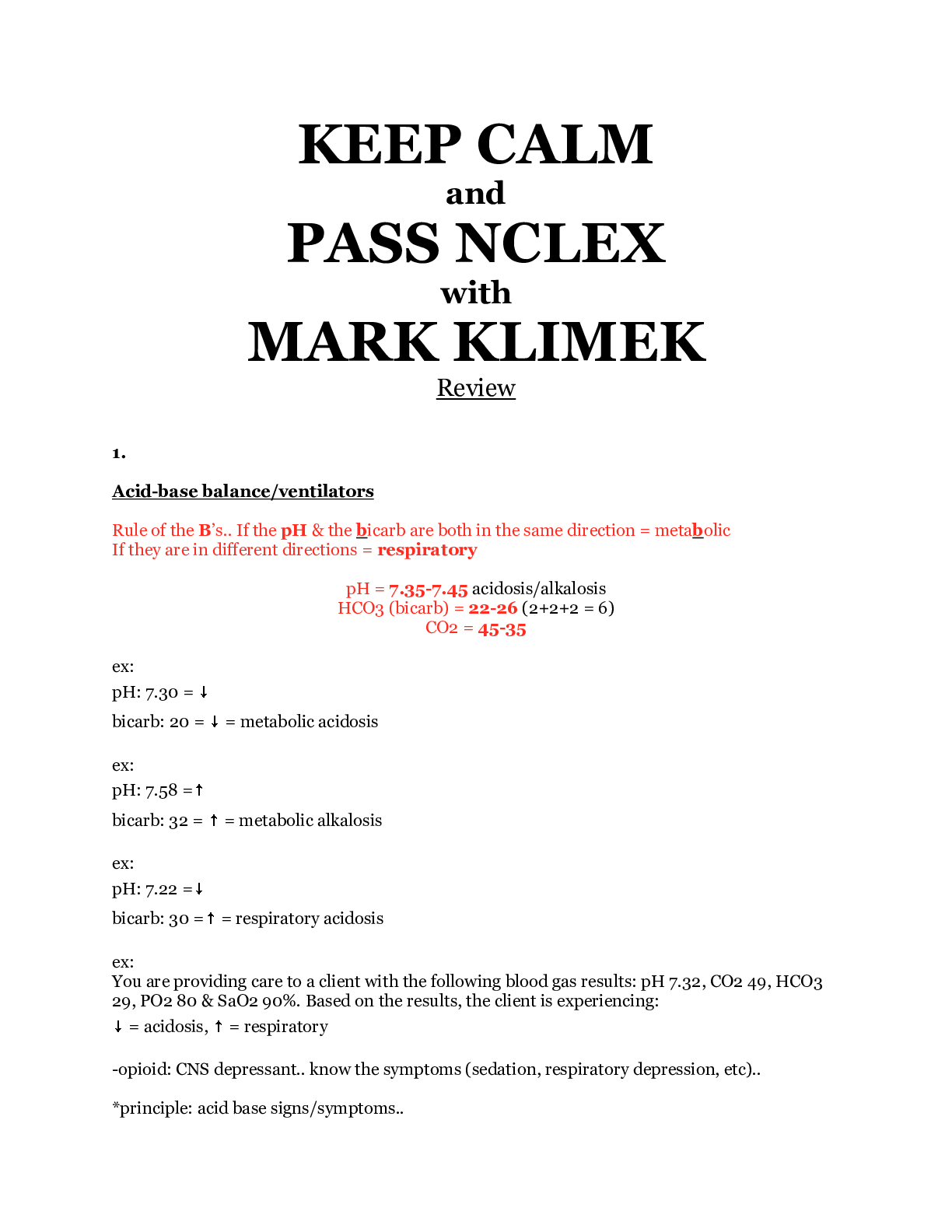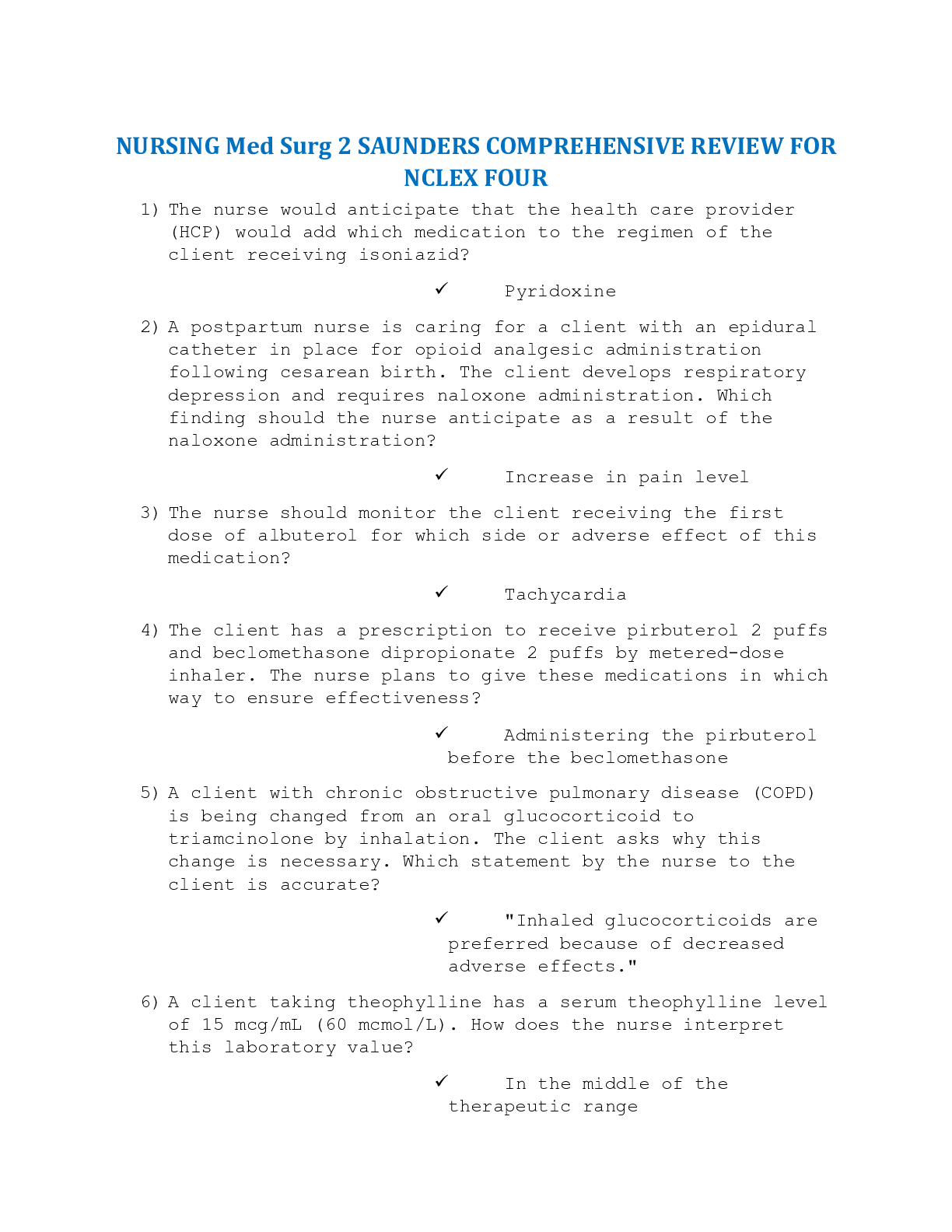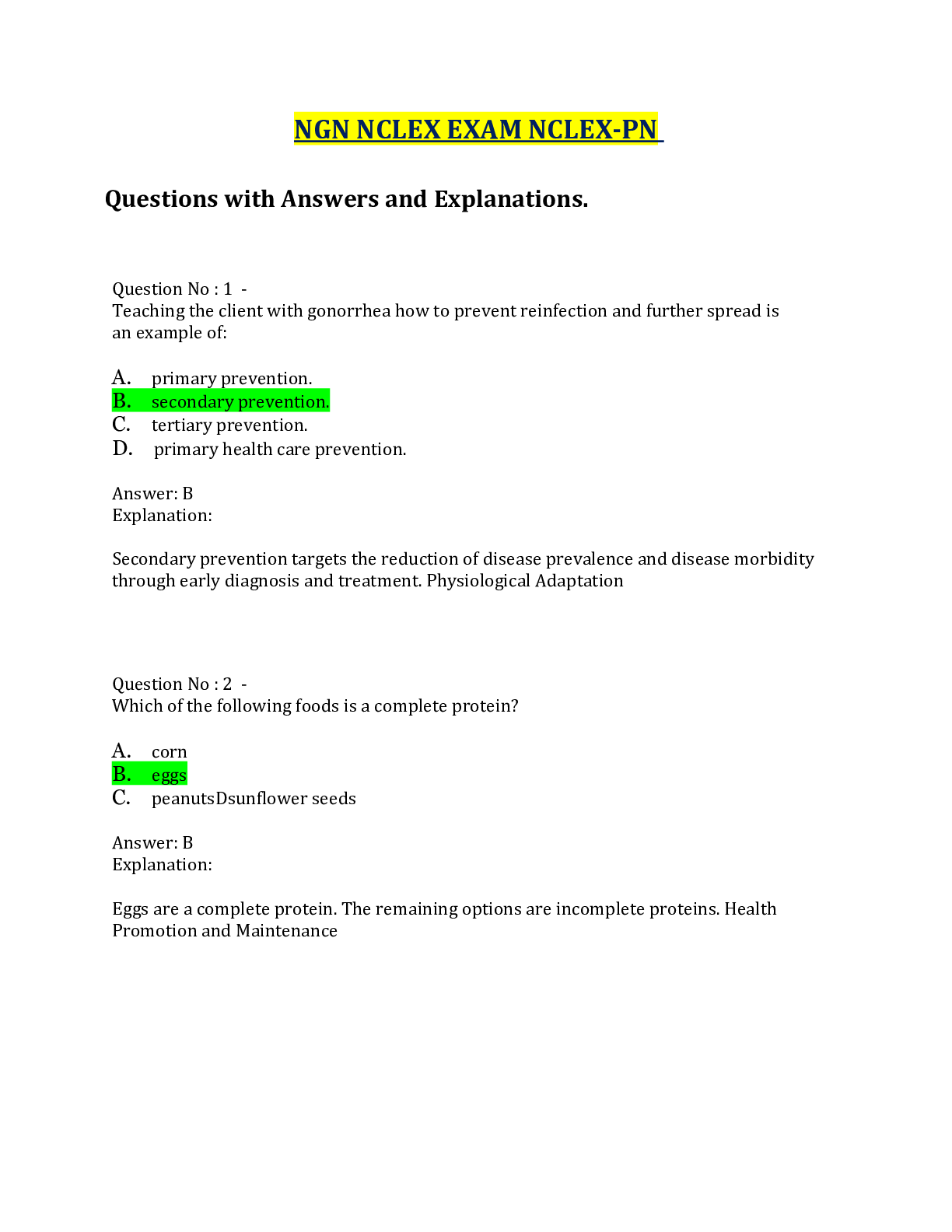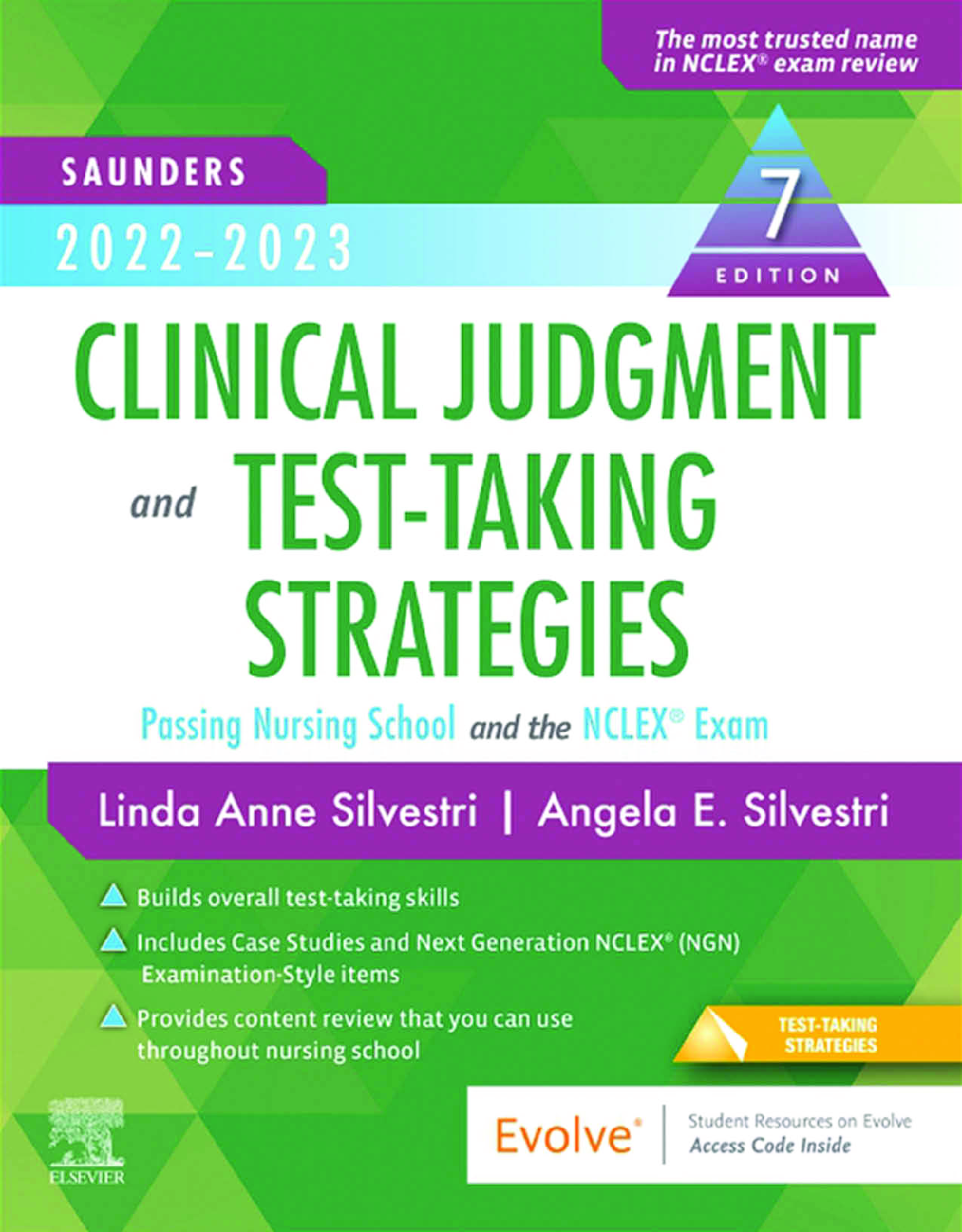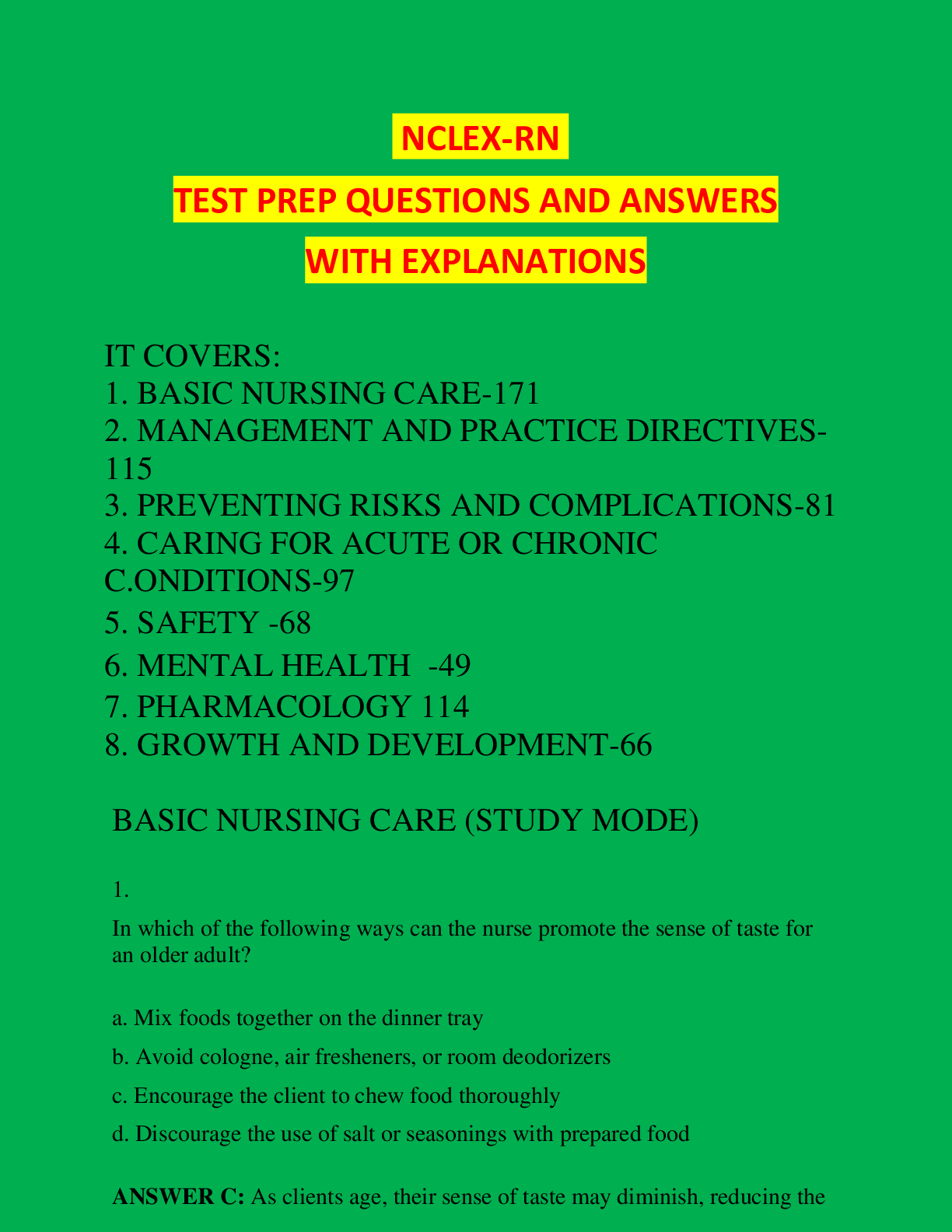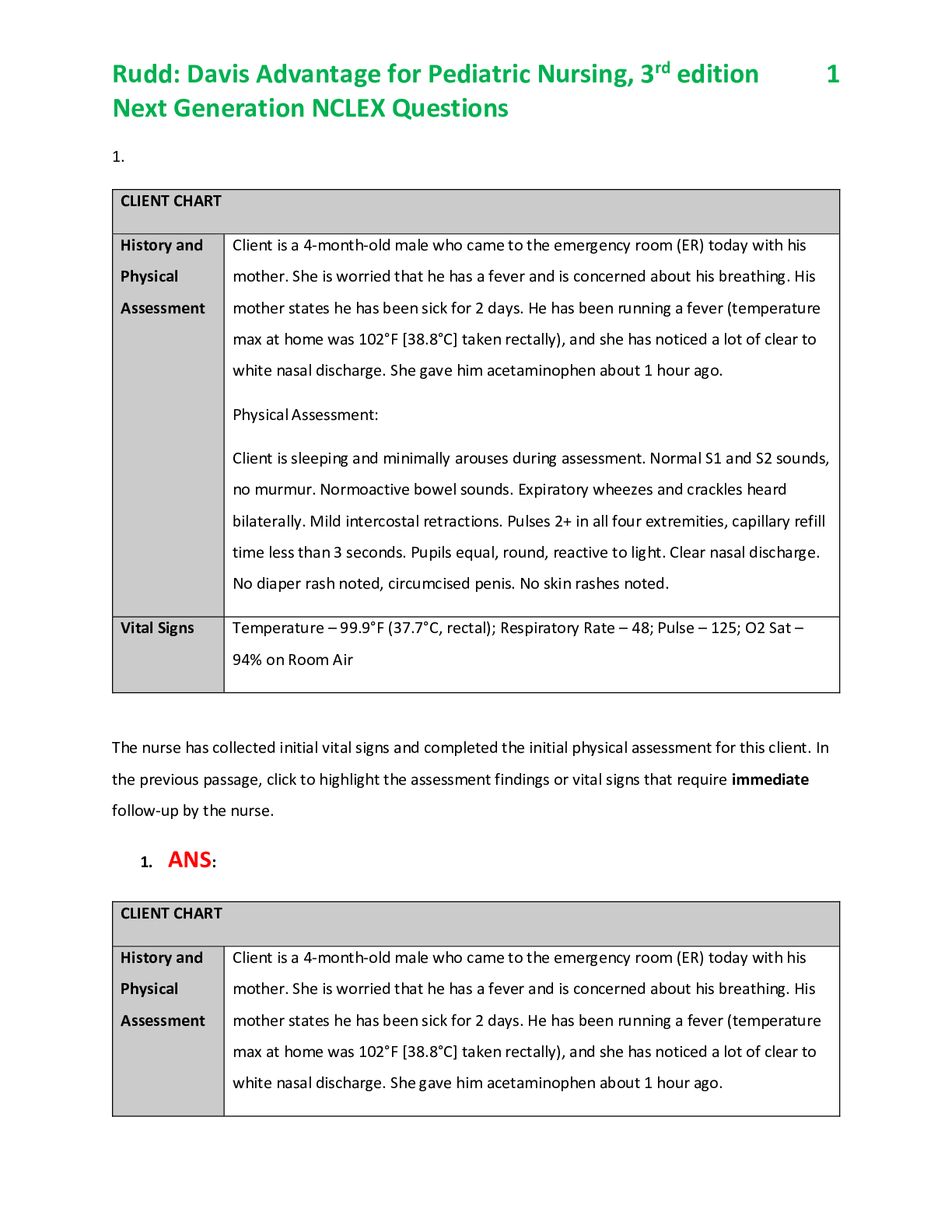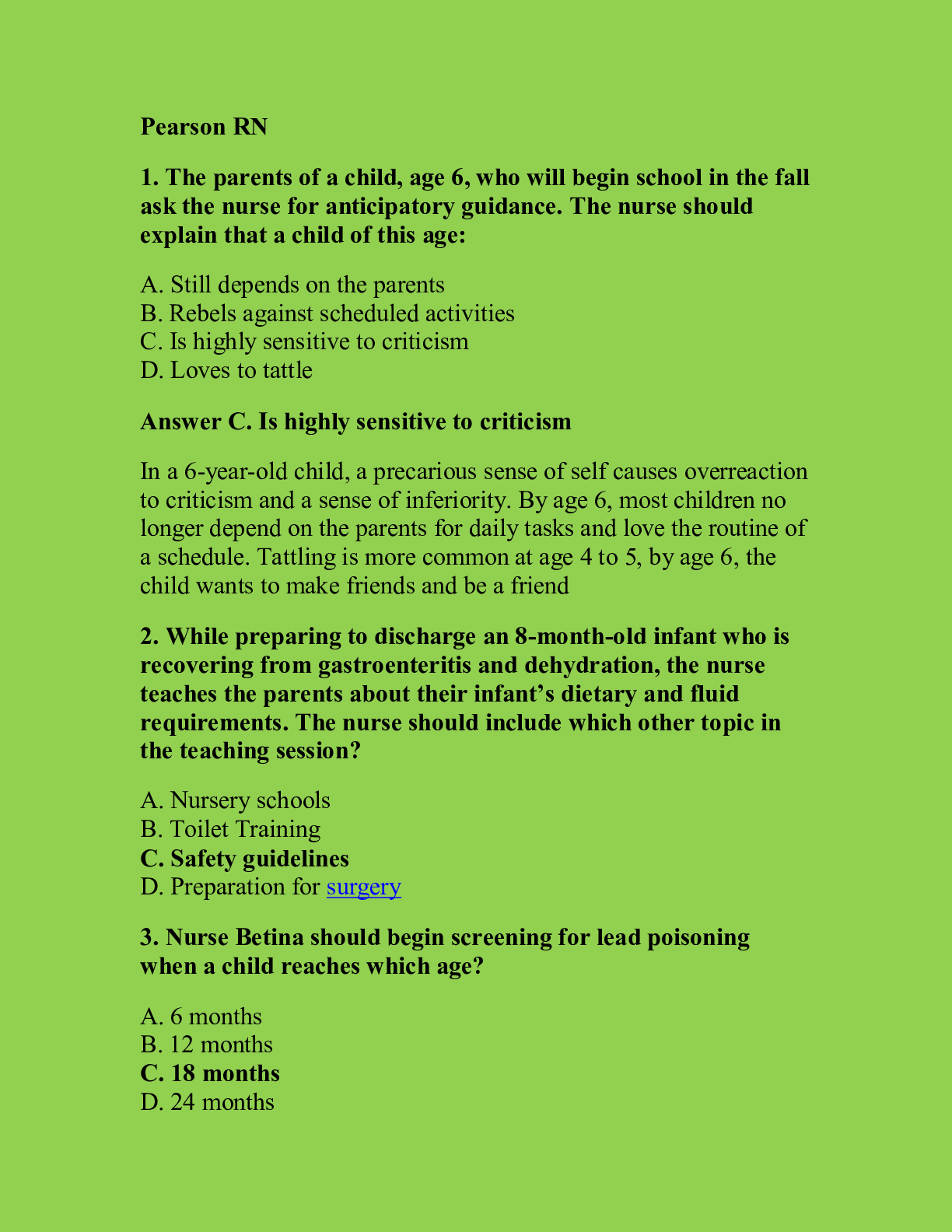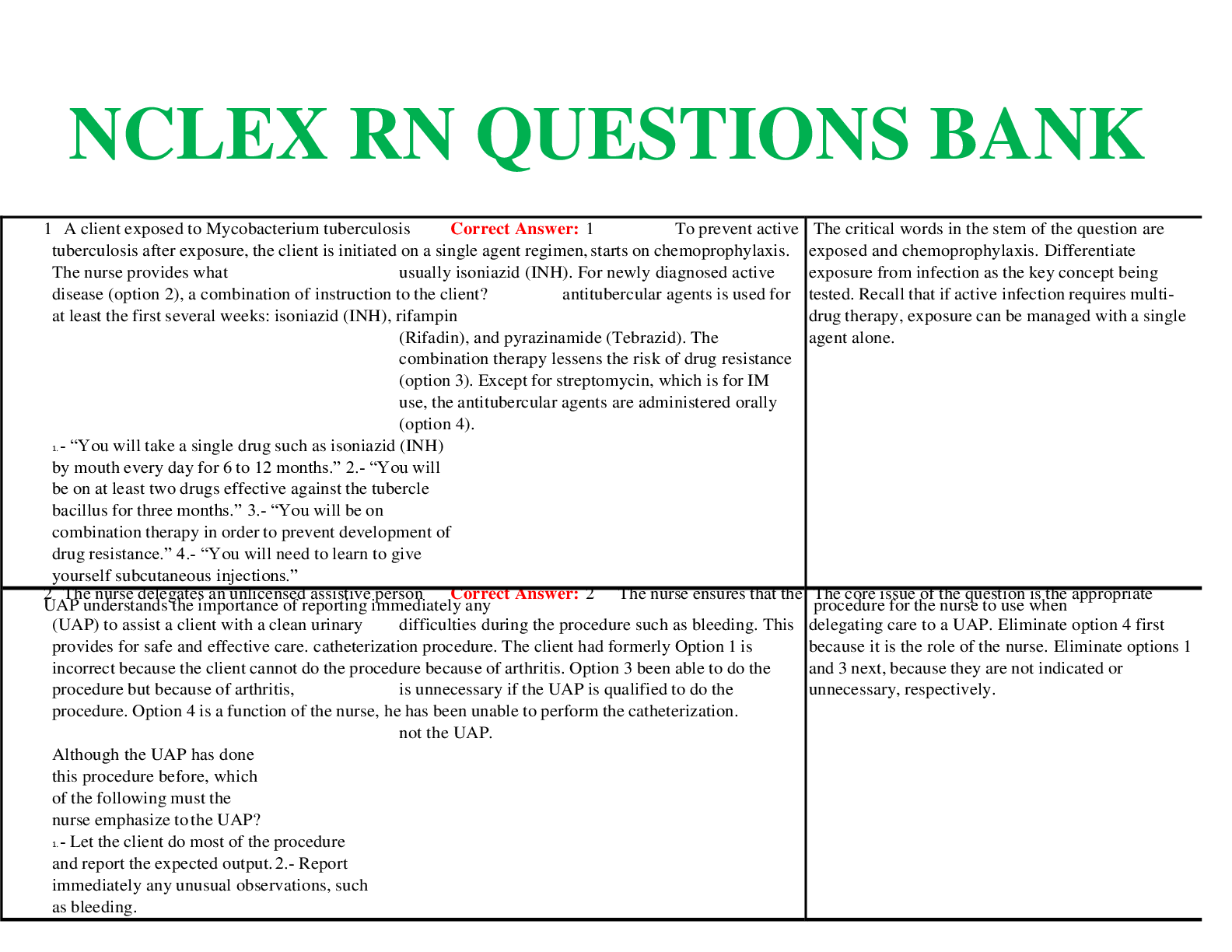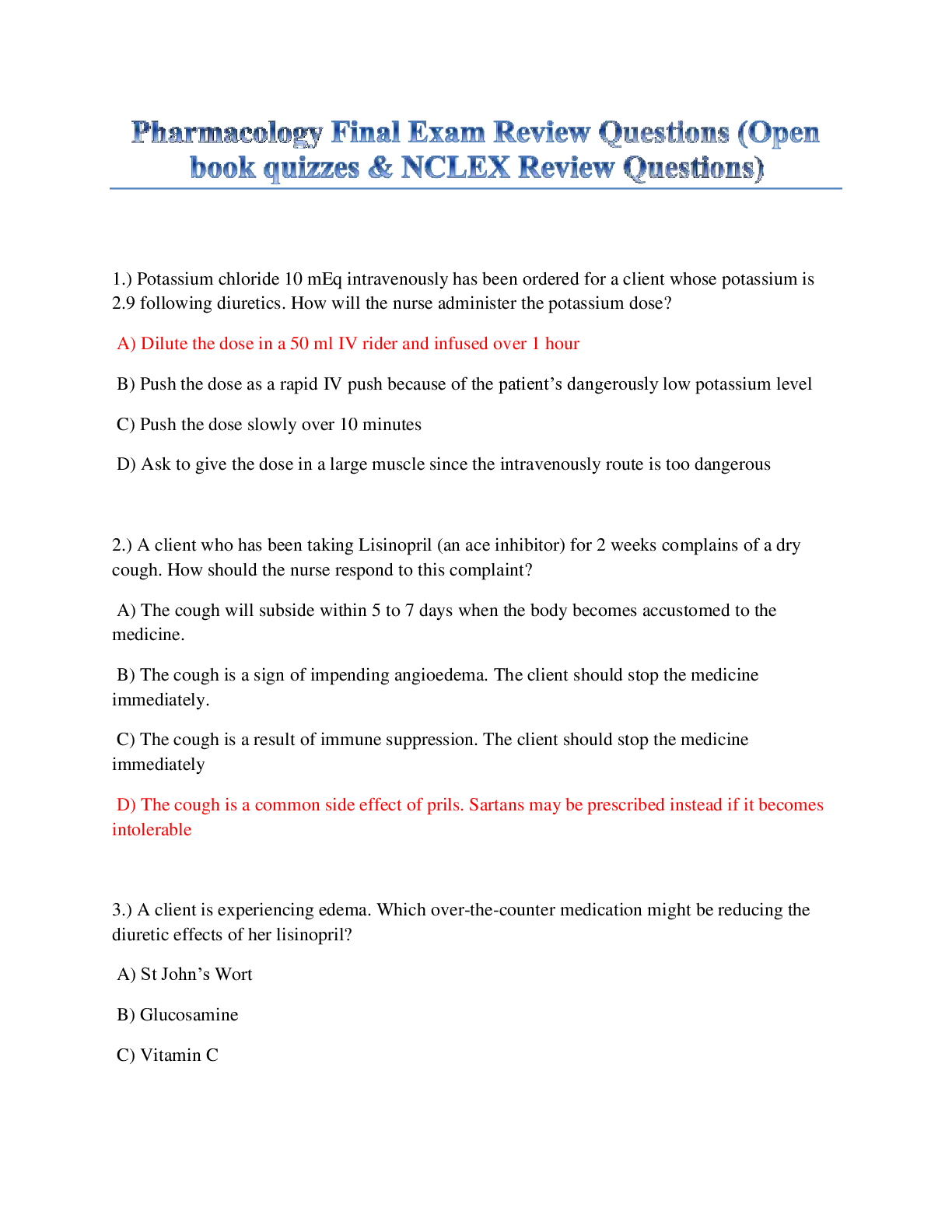*NURSING > NCLEX > Kill Your Exams at First Attempt with NCLEX-RN-Questions & Answers ( 541 pages ) (All)
Kill Your Exams at First Attempt with NCLEX-RN-Questions & Answers ( 541 pages )
Document Content and Description Below
Question: 1 On the third postpartum day, the nurse would expect the lochia to be: A. Rubra B. Serosa C. Alba D. Scant Answer: A Explanation: (A) This discharge occurs from delivery through the... 3rd day. There is dark red blood, placental debris, and clots. (B) This discharge occurs from days 4-10. The lochia is brownish, serous, and thin. (C) This discharge occurs from day 10 through the 6thweek. The lochia is yellowish white. (D) This is not a classification of lochia but relates to the amount of discharge. Question: 2 A pregnant client is having a nonstress test (NST). It is noted that the fetal heart beat rises 20 bpm, lasting 20 seconds, every time the fetus moves. The nurse explains that: A. The test is inconclusive and should be repeated B. Further testing is needed C. The test is normal and the fetus is reacting appropriately D. The fetus is distressed Answer: C Explanation: (A) The test results were normal, so there would be no need to repeat to determine results. (B) There are no data to indicate further tests are needed, because the result of the NST was normal. (C) An NST is reported as reactive if there are two to three increases in the fetal heart rate of 15 bpm, lasting at least 15 seconds during a 15-minute period. (D) The NST results were normal, so there was no fetal distress. Question: 3 Which stage of labor lasts from delivery of the baby to delivery of the placenta? A. Second B. Third C. Fourth D. Fifth Answer: B Explanation: (A) This stage is from complete dilatation of the cervix to delivery of the fetus. (B) This is the correct stage for the definition. (C) This stage lasts for about 2 hours after the delivery of the placenta. (D) There is no fifth stage of labor. Question: 4 A client develops complications following a hysterectomy. Blood cultures reveal Pseudomonas aeruginosa. The nurse expects that the physician would order an appropriate antibiotic to treat P. aeruginosa such as: A. Cefoperazone (Cefobid) B. Clindamycin (Cleocin) C. Dicloxacillin (Dycill) D. Erythromycin (Erythrocin)Answer: A Explanation: (A) Cefoperazone is indicated in the treatment of infection withPseudomonas aeruginosa.(B) Clindamycin is not indicated in the treatment of infection withP. aeruginosa.(C) Dicloxacillin is not indicated in the treatment of infection withP. aeruginosa.(D) Erythromycin is not indicated in the treatment of infection withP. aeruginosa. Question: 5 A couple is experiencing difficulties conceiving a baby. The nurse explains basal body temperature (BBT) by instructing the female client to take her temperature: A. Orally in the morning and at bedtime B. Only one time during the day as long as it is always at the same time of day C. Rectally at bedtime D. As soon as she awakens, prior to any activity Answer: D Explanation: (A) Monitoring temperature twice a day predicts the biphasic pattern of ovulation. (B) Prediction of ovulation relies on consistency in taking temperature. (C)Nightly rectal temperatures are more accurate in predicting ovulation. (D) Activity changes the accuracy of basal body temperature and ability to detect the luteinizing hormone surge. Question: 6 A client is having episodes of hyperventilation related to her surgery that is scheduled tomorrow. Appropriate nursing actions to help control hyperventilating include: A. Administering diazepam (Valium) 1015 mg po q4h and q1h prn for hyperventilating episode B. Keeping the temperature in the client’s room at a high level to reduce respiratory stimulation C. Having the client hold her breath or breathe into a paper bag when hyperventilation episodes occur D. Using distraction to help control the client’s hyperventilation episodes Answer: C Explanation: (A) An adult diazepam dosage for treatment of anxiety is 210 mg PO 24 times daily. The order as written would place a client at risk for overdose. (B) A high room temperature could increase hyperventilating episodes by stimulating the respiratory system. (C) Breath holding and breathing into a paper bag may be useful in controlling hyperventilation. Both measures increase CO2 retention. (D) Distraction will not prevent or control hyperventilation caused by anxiety or fear. Question: 7 A client delivered a stillborn male at term. An appropriate action of the nurse would be to: A. State, "You have an angel in heaven." B. Discourage the parents from seeing the baby. C. Provide an opportunity for the parents to see and hold the baby for an undetermined amount of time. D. Reassure the parents that they can have other children. Answer: C Explanation: (A) This is not a supportive statement. There are also no data to indicate the family’s religious beliefs. (B) Seeing their baby assists the parents in the grieving process. This gives them the opportunity to say "good-bye." (C) Parents need time to get to know their baby. (D) This is not a comforting statement when a baby has died. Thereare also no guarantees that the couple will be able to have another child. Question: 8 A 29-year-old client is admitted for a hysterectomy. She has repeatedly told the nurses that she is worried about having this surgery, has not slept well lately, and is afraid that her husband will not find her desirable after the surgery. Shortly into the preoperative teaching, she complains of a tightness in her chest, a feeling of suffocation, lightheadedness, and tingling in her hands. Her respirations are rapid and deep. Assessment reveals that the client is: A. Having a heart attack B. Wanting attention from the nurses C. Suffering from complete upper airway obstruction D. Hyperventilating Answer: D Explanation: (A) Classic symptoms of a heart attack include heaviness or squeezing pain in the chest, pain spreading to the jaw, neck, and arm. Nausea and vomiting, sweating, and shortness of breath may be present. The client does not exhibit these symptoms. (B) Clients suffering from anxiety or fear prior to surgical procedures may develop hyperventilation. This client is not seeking attention. (C) Symptoms of complete airway obstruction include not being able to speak, and no airflow between the nose and mouth. Breath sounds are absent. (D) Tightness in the chest; a feeling of suffocation; lightheadedness; tingling in the hands; and rapid, deep respirations are signs and symptoms of hyperventilation. This is almost always a manifestation of anxiety. Question: 9 A 44-year-old client had an emergency cholecystectomy 3 days ago for a ruptured gallbladder. She complains of severe abdominal pain. Assessment reveals abdominal rigidity and distention, increased temperature, and tachycardia. Diagnostic testing reveals an elevated WBC count. The nurse suspects that the client has developed: A. Gastritis B. Evisceration C. Peritonitis D. Pulmonary embolism Answer: C Explanation: (A) Assessment findings for gastritis would reveal anorexia, nausea and vomiting, epigastric fullness and tenderness, and discomfort. (B) Evisceration is the extrusion of abdominal viscera as a result of trauma or sutures failing in a surgical incision. (C) Peritonitis, inflammation of the peritoneum, can occur when an abdominal organ, such as the gallbladder, perforates and leaks blood and fluid into the abdominal cavity. This causes infection and irritation. (D) Assessment findings of pulmonary embolism would reveal severe substernal chest pain, tachycardia, tachypnea, shortness of breath, anxiety or panic, and wheezing and coughing often accompanied by blood-tinged sputum. Question: 10 A 35-year-old client is admitted to the hospital for elective tubal ligation. While the nurse is doing preoperative teaching, the client says, "The anesthesiologist said she was going to give me balanced anesthesia. What exactly is that?" The best explanation for the nurse to give the client would be that balanced anesthesia: A. Is a type of regional anesthesia B. Uses equal amounts of inhalation agents and liquid agents C. Does not depress the central nervous system D. Is a combination of several anesthetic agents or drugs producing a smooth induction and minimal complicationsAnswer: D Explanation: (A) Regional anesthesia does not produce loss of consciousness and is indicated for excision of moles, cysts, and endoscopic surgeries. (B) Varying amounts of anesthetic agents are used when employing balanced anesthesia. Amounts depend on age, weight, condition of the client, and surgical procedure. (C) General anesthesia is a druginduced depression of the central nervous system that produces loss of consciousness and decreased muscle activity. (D) Balanced anesthesia is a combination of a number of anesthetic agents that produce a smooth induction, appropriate depth of anesthesia, and appropriate muscle relaxation with minimal complications. Question: 11 Following a gastric resection, a 70-year-old client is admitted to the postanesthesia care unit. He was extubated prior to leaving the suite. On arrival at the postanesthesia care unit, the nurse should: A. Check airway, feeling for amount of air exchange noting rate, depth, and quality of respirations B. Obtain pulse and blood pressure readings noting rate and quality of pulse C. Reassure the client that his surgery is over and that he is in the recovery room D. Review physician’s orders, administering medications as ordered Answer: A Explanation: (A) Adequate air exchange and tissue oxygenation depend on competent respiratory function. Checking the airway is the nurse’s priority action. (B) Obtaining the vital signs is an important action, but it is secondary to airway management. (C) Reorienting a client to time, place, and person after surgery is important, but it is secondary to airway and vital signs. (D) Airway management takes precedence over physician’s orders unless they specifically relate to airway management. Question: 12 A 25-year-old client is admitted for a tonsillectomy. She tells the nurse that she has had episodes of muscle cramps, weakness, and unexplained temperature elevation. Many years ago her father died shortly after surgery after developing a high fever. She further tells the nurse that her surgeon is having her take dantrolene sodium (Dantrium) prophylactically prior to her tonsillectomy. Dantrolene sodium is ordered preoperatively to reduce the risk or prevent: A. Infection postoperatively B. Malignant hyperthermia C. Neuroleptic malignant syndrome D. Fever postoperatively Answer: B Explanation: (A, D) Dantrolene sodium is a peripheral skeletal muscle relaxant and would have no effect on a postoperative infection. (B) Dantrolene sodium is indicated prophylactically for clients with malignant hyperthermia or with a family history of the disorder. The mortality rate for malignant hyperthermia is high. (C) Neuroleptic malignant syndrome is an exercise-induced muscle pain and spasm and is unrelated to malignant hyperthermia. Question: 13 The family member of a child scheduled for heart surgery states, "I just don’t understand this open-heart or closedheart business. I’m so confused! Can you help me understand it?" The nurse explains that patent ductus arteriosus repair is: A. Open-heart surgery. The child will be placed on a heart-lung machine while the surgery is being performed. B. Closed-heart surgery. It does not require that the child be placed on the heart-lung machine while the surgery is being performed. C. A pediatric version of the coronary artery bypass graft surgery performed on adults. It is an open-heartsurgery. D. A pediatric version of percutaneous transluminal coronary angioplasty performed on adults. It is a closed-heart surgery. Answer: B Explanation: (A) Patent ductus arteriosus repair is a closed-heart procedure. The client is not placed on a heart-lung machine. (B) Patent ductus arteriosus is a ductus arteriosus that does not close shortlyafter birth but remains patent. Repair is a closed-heart procedure involving ligation of the patent ductus arteriosus. (C) Coronary artery bypass graft surgery is an open-heart surgical procedure in which blocked coronary arteries are bypassed using vessel grafts. (D) Percutaneous transluminal coronary angioplasty is a closedheart procedure that improves coronary blood flow by increasing the lumen size of narrowed vessels. Question: 14 A child is to receive atropine 0.15 mg (1/400 g) as part of his preoperative medication. A vial containing atropine 0.4 mg (1/150 g)/mL is on hand. How much atropine should be given? A. 0.06 mL B. 0.38 mL C. 2.7 mL D. Information given insufficient to determine the amount of atropine to be administered Answer: B Explanation: (A, C) Information was incorrectly placed in the formula, resulting in an incorrect answer. (B) The answer is correct. 0.4 mg = 1 mL:0.15 mg 5 = mL 0.4 x = 0.15 x = 0.15/0.4 x = 0.375 or 0.38 mL (D)Sufficient information is provided to determine the amount of atropine to administer. The amount of atropine available and the amount of atropine ordered is required to determine the amount of atropine to be given. Question: 15 A 47-year-old male client is admitted for colon surgery. Intravenous antibiotics are begun 2 hours prior to surgery. He has no known infection. The rationale for giving antibiotics prior to surgery is to: A. Provide cathartic action within the colon B. Reduce the risk of wound infection from anaerobic bacteria C. Relieve the client’s concern regarding possible infection D. Reduce the risk of intraoperative fever Answer: B Explanation: (A) Cathartic drugs promote evacuation of intestinal contents. (B) The client undergoing intestinal surgery is at increased risk for infection from large numbers of anaerobic bacteria that inhabit the intestines. Administering antibiotics prophylactically can reduce the client’s risk for infection. (C) Antibiotics are indicated in the treatment of infections and have no effect on emotions. (D) Antipyretics are useful in the treatment of elevated temperatures. Antibiotics would have an effect on infection, which causes temperature elevation, but would not directly affect such an elevation. Question: 16 A 19-month-old child is admitted to the hospital for surgical repair of patent ductus arteriosus. The child is beinggiven digoxin. Prior to administering the medication, the nurse should: A. Not give the digoxin if the pulse is_60 B. Not give the digoxin if the pulse is_100 C. Take the apical pulse for a full minute D. Monitor for visual disturbances, a side effect of digoxin Answer: C Explanation: (A) Digoxin should not be given to adults with an apical pulse < 60 bpm. (B) Digoxin should be given to children with an apical pulse > 100 bpm. With a pulse < 100 bpm, the medication should be withheld and the physician notified. (C) Prior to digoxin administration in both children and adults, an apical pulse should be taken for 1 full minute. Aside from the rate per minute, the nurse should note any sudden increase or decrease in heart rate, irregular rhythm, or regularization of a chronic irregular heart rhythm. (D) Early indications of digoxin toxicity, such as visual disturbances, occur rarely as initial signs in children. Question: 17 A 35-year-old client has returned to her room following surgery on her right femur. She has an IV of D5 in onehalf normal saline infusing at 125 mL/hr and is receiving morphine sulfate 1015 mg IM q4h prn for pain. She last voided 51/2 hours ago when she was given her preoperative medication. In monitoring and promoting return of urinary function after surgery, the nurse would: A. Provide food and fluids at the client’s request B. Maintain IV, increasing the rate hourly until the client voids C. Report to the surgeon if the client is unable to void within 8 hours of surgery D. Hold morphine sulfate injections for pain until the client voids, explaining to her that morphine sulfate can cause urinary retention Answer: C Explanation: (A) Provision of food and fluid promotes bowel elimination. Nutritional needs postoperatively are determined by the physician, not the client. (B) Increasing IV fluids postoperatively will not cause a client to void. Any change in rate of administration of IV fluids should be determined by the physician. (C) The postoperative client with normal kidney function who cannot void 8 hours after surgery is retaining urine. The client may need catheterization or medication. The physician must provide orders for both as necessary. (D) Although morphine sulfate can cause urinary retention, withholding pain medication will not ensure that the client will void. The client with uncontrolled pain will probably not be able to void. Question: 18 A client develops an intestinal obstruction postoperatively. A nasogastric tube is attached to low, intermittent suction with orders to "Irrigate NG tube with sterile saline q1h and prn." The rationale for using sterile saline, as opposed to using sterile water to irrigate the NG tube is: A. Water will deplete electrolytes resulting in metabolic acidosis. B. Saline will reduce the risk of severe, colicky abdominal pain during NG irrigation. C. Water is not isotonic and will increase restlessness and insomnia in the immediate postoperative period. D. Saline will increase peristalsis in the bowel. Answer: A Explanation: (A) Water is a hypotonic solution and will deplete electrolytes and cause metabolic acidosis when used for nasogastric irrigation. (B) Irrigating with saline does not cause abdominal discomfort. Severe, colicky abdominal pain is a symptom of intestinal obstruction. (C) Irrigating with water will not cause restlessness or insomnia in the postoperative client. Restlessness and insomnia can be emotional complications of surgery. (D) A nasogastric tubeplaced in the stomach is used to decompress the bowel. Irrigating with saline ensures a patent, well- functioning tube. Irrigating with saline will not increase peristalsis. Question: 19 The nurse writes the following nursing diagnosis for a client in acute renal failure–Impaired gas exchange related to: A. Decreased red blood cell production B. Increased levels of vitamin D C. Increased red blood cell production D. Decreased production of renin Answer: A Explanation: (A) Red blood cell production is impaired in renal failure owing to impaired erythropoietin production. This causes a decrease in the delivery of oxygen to the tissue and impairs gas exchange. (B) The conversion of vitamin D to its physiologically active form is impaired in renal failure. (C) In renal failure, a decrease in red blood cell production occurs owing to an impaired production of erythropoietin, leading to impaired gas exchange at the cellular level. (D) The decreased production of renin in renal failure causes an increased production of aldosterone causing sodium and water retention. Question: 20 A 6-year-old child returned to the surgical floor 20 hours ago after an appendectomy for a gangrenous appendix. His mother tells the nurse that he is becoming more restless and is anxious. Assessment findings indicate that the child has atelectasis. Appropriate nursing actions would include: A. Allowing the child to remain in the position of comfort, preferably semi-or high-Fowler position B. Administering analgesics as ordered C. Having the child turn, cough, and deep breathe every 12 hours D. Remaining with the child and keeping as calm and quiet as possible Answer: C Explanation: (A) Allowing the client to remain in the position of comfort will not resolve the atelectasis. This position, if left unchanged, over time may actually increase the atelectasis. (B) Analgesics will not resolve the atelectasis and may contribute to it if proper nursing actions are not taken to help resolve the atelectasis. (C) Having the client turn, cough, and deep breathe every 12 hours will aid in resolving the atelectasis. Surgery clients are at risk for postoperative respiratory complications because pulmonary function is reduced as a result of anesthesia and surgery. (D) Remaining with the client and keeping him calm and quiet will not affect the client’s anxiety, restlessness, or help to resolve the atelectasis. The cause (atelectasis) needs to be treated, not the symptoms (anxiety and restlessness). Question: 21 A 52-year-old female client is admitted to the hospital in acute renal failure. She has been on hemodialysis for the past 2 years. Stat arterial blood gases are drawn on the client yielding the following results: pH 7.30, PCO2 51 mm Hg, HCO3, 18 mEq/L, PaO2, 84 mm Hg. The nurse would interpret these results as: A. Compensated metabolic alkalosis B. Respiratory acidosis C. Partially compensated metabolic alkalosis D. Combined respiratory and metabolic acidosis Answer: D Explanation:(A) Compensated metabolic alkalosis would be reflected by the following: pH within normal limit (7.357.45), PCO2 > 45 mm Hg, HCO3 >26 mEq/L. (B) Respiratory acidosis would be reflected by the following: pH < 7.35, PCO2 > 45 mm Hg, HCO3 within normal limits (2226 mEq/L). (C) Partially compensated metabolic alkalosis would be reflected by the following: pH > 7.45, PCO2 > 45 mm Hg, HCO3 > 26 mEq/L. (D) Combined respiratory and metabolicacidosis would be reflected by the following: pH < 7.35, PCO2 > 45 mm Hg, HCO3 < 22 mEq/L. Question: 22 Stat serum electrolytes ordered for a client in acute renal failure revealed a serum potassium level of 6.4. The physician is immediately notified and orders 50 mL of dextrose and 10 U of regular insulin IV push. The nurse administering these drugs knows the Rationale for this therapy is to: A. Remove the potassium from the body by renin exchange B. Protect the myocardium from the effects of hypokalemia C. Promote rapid protein catabolism D. Drive potassium from the serum back into the cells Answer: D Explanation: (A) Sodium polystyrene sulfonate (Kayexalate), a cation exchange resin, exchanges sodium ions for potassium ions in the large intestine reducing the serum potassium. (B) Calcium is administered to protect the myocardium from the adverse effects of hyperkalemia. Serum levels reflect hyperkalemia. (C)Rapid catabolism releases potassium from the body tissue into the bloodstream. Infection and hyperthermia increase the process of catabolism. (D)The administration of dextrose and regular insulin IV forces potassium back into the cells decreasing the potassium in the serum. Question: 23 The following nursing diagnosis is written for a comatose client with cirrhosis of the liver and secondary splenomegaly–High risk for injury: Increased susceptibility to bleeding related to: A. Increased absorption of vitamin K B. Thrombocytopenia due to hypersplenism C. Diminished function of the Kupffer cells D. Increased synthesis of the clotting factors Answer: B Explanation: (A) There is a decreased absorption of vitamin K with cirrhosis of the liver. This decrease impairs blood coagulation and the formation of prothrombin. (B) Thrombocytopenia, an increased destruction of platelets, occurs secondary to hypersplenism. (C) A diminished function of the Kupffer cells occurs with cirrhosis of the liver, causing the client to become more susceptible to infections. (D) A decrease in the synthesis of fibrinogen and clotting factors VII, IX, and X occurs with cirrhosis of the liver and increases the susceptibility to bleeding. Question: 24 During the assessment, the nurse observes a client scratching his skin. He has been admitted to rule out Laennec’s cirrhosis of the liver. The nurse knows the pruritus is directly related to: A. A loss of phagocytic activity B. Faulty processing of bilirubin C. Enhanced detoxification of drugs D. The formation of collateral circulation Answer: B Explanation: (A) A loss in the phagocytic activity of the Kupffer cells occurs with cirrhosis of the liver, which increases thesusceptibility to infections. (B) The faulty processing of bilirubin produces bilesalts, which are irritating to the skin. (C) The detoxification of drugs is impaired with cirrhosis of the liver. (D)Collateral circulation develops due to portal hypertension. This is manifest through the development of esophageal varices, hemorrhoids, and caput medusae. Question: 25 Four days after admission for cirrhosis of the liver, the nurse observes the following when assessing a male client: increased irritability, asterixis, and changes in his speech pattern. Which of the following foods would be appropriate for his bedtime snack? A. Fresh fruit B. A milkshake C. Saltine crackers and peanut butter D. A ham and cheese sandwich Answer: A Explanation: (A) High levels of ammonia, a by-product of protein metabolism, can precipitate metabolic encephalopathy. These clients need a diet high in carbohydrates and bulk. (B) Metabolic encephalopathy of the brain associated with liver failure is precipitated by elevated ammonia levels. Ammonia is a by-product of protein metabolism. (C, D) Metabolic encephalopathy in liver failure is precipitated by elevated ammonia levels. Ammonia is a byproduct of protein metabolism. Question: 26 Four days after admission for cirrhosis of the liver, the nurse observes the following when assessing a male client: increased irritability, asterixis, and changes in his speech pattern. Which of the following foods would be appropriate for his bedtime snack? A. Fresh fruit B. A milkshake C. Saltine crackers and peanut butter D. A ham and cheese sandwich Answer: B Explanation: (A) Albumin, a blood volume expander, increases the circulating blood volume by exerting an osmotic pull on tissue fluids, pulling them into the vascular system. This fluid shift causes an increase in the heart rate and blood pressure. (B) Albumin, a blood volume expander, exerts an osmotic pull on fluids in the interstitial spaces, pulling the fluid back into the circulatory system. This fluid shift causes an increase in the urinary output. (C) Adventitious breath sounds and dyspnea can occur due to circulatory overload if the albumin is infused too rapidly. (D) Chills, fever, itching, and rashes are signs of a hypersensitivity reaction to albumin. Question: 27 A client with cirrhosis of the liver becomes comatose and is started on neomycin 300 mg q6h via nasogastric tube. The rationale for this therapy is to: A. Prevent systemic infection B. Promote diuresis C. Decrease ammonia formation D. Acidify the small bowel Answer: C Explanation: (A) Neomycin is an antibiotic, but this is not the Rationale for administering it to a client in hepatic coma. (B)Diuretics and salt-free albumin are used to promote diuresis in clients with cirrhosis of the liver. (C) Neomycin destroys the bacteria in the intestines. It is the bacteria in the bowel that break down protein into ammonia. (D) Lactulose is administered to create an acid environment in the bowel. Ammonia leaves the blood and migrates to this acidic environment where it is trapped and excreted. Question: 28 The nurse notes multiple bruises on the arms and legs of a newly admitted client with lupus. The client states, "I get them whenever I bump into anything." The nurse would expect to note a decrease in which of the following laboratory tests? A. Number of platelets B. WBC count C. Hemoglobin level D. Number of lymphocytes Answer: A Explanation: (A) Thrombocytopenia, a decrease in platelets, occurs in lupus and causes a decrease in blood coagulation and thrombus formation. (B) Clients with lupus will have a decrease in the WBC count decreasing their resistance to infection. (C) Clients with lupus may have a decrease in the hemoglobin level causing anemia. (D) Leukopenia, a decrease in white blood cells, is seen in lupus and decreases resistance to infection. Question: 29 A client is started on prednisone 2.5 mg po bid. Which of the following instructions should be included in her discharge teaching specific to this medication? A. Increase your oral intake of fluids to at least 4000 mL every day. B. Avoid contact with people who have contagious illnesses. C. Brush your teeth at least 4 times a day with a firm toothbrush. D. Immediately stop taking the prednisone if you feel depressed. Answer: B Explanation: (A) Fluid retention is a side effect of prednisone. The nurse should teach clients to weigh themselves daily and to observe for signs of edema. If these signs of fluid retention occur, they should notify the physician. (B) Prednisone, a glucocorticoid, suppresses the normal immune response making the client more susceptible to infections. (C) An increase in bleeding tendencies is a side effect of prednisone therapy. The nurse should teach clients to use preventive measures (i.e., electric razors and soft toothbrushes). (D) Depression and personality changes are side effects of prednisone therapy. Prednisone should never be discontinued abruptly. Question: 30 When assessing a client, the nurse notes the typical skin rash seen with systemic lupus erythematosus. Which of the following descriptions correctly describes this rash? A. Small round or oval reddish brown macules scattered over the entire body B. Scattered clusters of macules, papules, and vesicles over the body C. Bright red appearance of the palmar surface of the hands D. Reddened butterfly shaped rash over the cheeks and nose Answer: D Explanation: (A) The appearance of small, round or oval reddish brown macules scattered over the entire body is characteristic of rubeola. (B) The appearance of scattered clusters of macules, papules, and vesicles throughout the body is characteristic of chickenpox. (C) Palmar redness is seen in clients with cirrhosis of the liver. (D) The characteristicbutterfly rash over the cheek and nose and into the scalp is seen with systemic lupus erythematosus. Question: 31 Morphine sulfate 4 mg IV push q2h prn for chest pain was ordered for a client in the emergency room with severe chest pain. The nurse administering the morphine sulfate knows which of the following therapeutic actions is related to the morphine sulfate? A. Increased level of consciousness B. Increased rate and depth of respirations C. Increased peripheral vasodilation D. Increased perception of pain Answer: C Explanation: (A) Morphine sulfate, a narcotic analgesic, causes sedation and a decrease in level of consciousness. (B) The side effects of morphine sulfate include respiratory depression. (C) Morphine sulfate causes peripheral vasodilation, which decreases afterload, producing a decrease in the myocardial workload. (D) Morphine sulfate alters the perception of pain through an unclear mechanism. This alteration promotes pain relief. Question: 32 A client had a cardiac catheterization with angiography and thrombolytic therapy with streptokinase. The nurse should initiate which of the following interventions immediately after he returns to his room? A. Place him on NPO restriction for 4 hours. B. Monitor the catheterization site every 15 minutes. C. Place him in a high Fowler position. D. Ambulate him to the bathroom to void. Answer: B Explanation: (A) A contrast dye, iodine, is used in this procedure. This dye is nephrotoxic. The client must be encouraged to drink plenty of liquids to assist the kidneys in eliminating the dye. (B) Streptokinase activates plasminogen, dissolving fibrin deposits. To prevent bleeding, pressure is applied at the insertion site. The client is assessed for both internal and external bleeding. (C) The extremity used for the insertion site must be kept straight and be immobilized because of the potential for bleeding. (D) The client is kept on bed rest for 812 hours following the procedure because of the potential for bleeding. Question: 33 The nurse notes scattered crackles in both lungs and 1+ pitting edema when assessing a cardiac client. The physician is notified and orders furosemide (Lasix) 80 mg IV push stat. Which of the following diagnostic studies is monitored to assess for a major complication of this therapy? A. Serum electrolytes B. Arterial blood gases C. Complete blood count D. 12-Lead ECG Answer: A Explanation: (A) Furosemide, a potassium-depleting diuretic, inhibits the reabsorption of sodium and chloride from the loop of Henle and the distal renal tubules. Serum electrolytes are monitored for hypokalemia. (B) Severe acid-base imbalances influence the movement of potassium into and out of the cells, but arterial blood gases to not measure the serum potassium level. (C) Furosemide is a potassium-depleting diuretic. A complete blood count does not reflect potassium levels. (D) Abnormalities in potassium (both hyperkalemia and hypokalemia) are reflected inECG changes, but these changes do not occur until the abnormality is severe. Question: 34 Prior to his discharge from the hospital, a cardiac client is started on digoxin (Lanoxin) 25 mg po qd. The nurse initiates discharge teaching. Which of the following statements by the client would validate an understanding of his medication? A. "I would notify my physician immediately if I experience nausea, vomiting, and double vision." B. "I could stop taking this medication when I begin to feel better." C. "I should only take the medication if my heart rate is greater than 100 bpm." D. "I should always take this medication with an antacid." Answer: A Explanation: (A) The first signs of digoxin toxicity include abdominal pain, anorexia, nausea, vomiting, and visual disturbances. The physician should be notified if any of these symptoms are experienced. (B) The positive inotropic effects of digoxin increase cardiac output and result in an enhanced activity tolerance. "Feeling better" indicates the drug is working and medication therapy must be continued. (C) Clients should be taught to take their pulse prior to taking the digoxin. If their pulse rate becomes irregular, slows significantly, or is >100 bpm the physician should be notified. (D) Antacids decrease the effectiveness of digoxin. Question: 35 A client is to be discharged from the hospital and is to continue taking warfarin 2.5 mg po bid. Which of the following should be included in her discharge teaching concerning the warfarin therapy? A. "If you forget to take your morning dose, double the night time dose." B. "You should take aspirin instead of acetaminophen (Tylenol) for headaches." C. "Carry a medications alert card with you at all times." D. "You should use a straight-edge razor when shaving your arms and legs." Answer: C Explanation: (A) Warfarin must always be taken exactly as directed. Clients should be instructed never to skip or double up on their dosage. (B) Aspirin decreases platelet aggregation, which would potentiate the effects of the coumadin. (C) Healthcare providers need to be aware of persons on warfarin therapy prior to the initiation of any diagnostic tests and/or surgery to help prevent bleeding complications. (D) An electric razor should be used to prevent accidental cutting, which can lead to bleeding. Question: 36 A 40-year-old client has been admitted to the hospital with severe substernal chest pain radiating down his left arm. The nurse caring for the client establishes the following priority nursing diagnosis–Alteration in comfort, pain related to: A. Increased excretion of lactic acid due to myocardial hypoxia B. Increased blood flow through the coronary arteries C. Decreased stimulation of the sympathetic nervous system D. Decreased secretion of catecholamines secondary to anxiety Answer: A Explanation: (A) Anaerobic metabolism results because the decreased blood supply to the myocardium causes a release of lactic acid. Lactic acid is an irritant to the myocardial neural receptors, producing chest pain. (B) Chest pain is caused by a decrease in the O2 supply to the myocardial cells. Treatment modalities for chest pain are aimed toward increasing the blood flow through coronary arteries. (C) Chest pain causes an increase in the stimulation of thesympathetic nervous system. This stimulation increases the heart rate and blood pressure, causing an increase in myocardial workload aggravating the chest pain. (D) Chest pain and anxiety cause increased secretion of catecholamines by stimulating the sympathetic nervous system. This stimulation increases chest pain by increasing the workload of the heart. Question: 37 A female client is started on warfarin (Coumadin) 5 mg po bid. To adequately evaluate the effectiveness of the warfarin therapy, the nurse must know that this medication: A. Dissolves any clots already formed in the arteries B. Prevents the conversion of prothrombin to thrombin C. Interferes with the synthesis of vitamin K-dependent clotting factors D. Stimulates the manufacturing of platelets Answer: C Explanation: (A) Thrombolytic agents (e.g., streptokinase) directly activate plasminogen, dissolving fibrin deposits, which in turn dissolves clots that have already formed. (B) Heparin prevents the formation of clots by potentiating the effects of antithrombin III and the conversion of prothrombin to thrombin. (C) Warfarin prevents the formation of clots by interfering with the hepatic synthesis of the vitamin K-dependent clotting factors. (D) Platelets initiate the coagulation of blood by adhering to each other and the site of injury to form platelet plugs. Question: 38 A male client is scheduled to have angiography of his left leg. The nurse needs to include which of the following when preparing the client for this procedure? A. Validate that he is not allergic to iodine or shellfish. B. Instruct him to start active range of motion of his left leg immediately following the procedure. C. Inform him that he will not be able to eat or drink anything for 4 hours after the procedure. D. Inform him that vital signs will be taken every hour for 4 hours after the procedure. Answer: A Explanation: (A) Angiography, an invasive radiographic examination, involves the injection of a contrast solution (iodine) through a catheter that has been inserted into an artery. (B) The client is kept on complete bed rest for 612 hours after the procedure. The extremity in which the catheter was inserted must be immobilized and kept straight during this time. (C) The contrast dye, iodine, is nephrotoxic. The client must be instructed to drink a large quantity of fluids to assist the kidneys in excreting this contrast media. (D) The major complication of this procedure is hemorrhage. Vital signs are assessed every 15 minutes initially for signs of bleeding. Question: 39 An 80-year-old male client with a history of arteriosclerosis is experiencing severe pain in his left leg that started approximately 20 minutes ago. When performing the admission assessment, the nurse would expect to observe which of the following: A. Both lower extremities warm to touch with 2_pedal pulses B. Both lower extremities cyanotic when placed in a dependent position C. Decreased or absent pedal pulse in the left leg D. The left leg warmer to touch than the right leg Answer: C Explanation: (A) This statement describes a normal assessment finding of the lower extremities. (B) This assessment finding reflects problems caused by venous insufficiency. (C) Decreased or absentpedal pulses reflect a problem caused byarterial insufficiency. (D) The leg that is experiencing arterial insufficiency would be cool to touch due to the decreased circulation. Question: 40 One of the most reliable assessment tools for adequacy of fluid resuscitation in burned children is: A. Blood pressure B. Level of consciousness C. Skin turgor D. Fluid intake Answer: B Explanation: (A) Blood pressure can remain normotensive in a state of hypovolemia. (B) Capillary refill, alterations in sensorium, and urine output are the most reliable indicators for assessing hydration. (C) Skin turgor is not a reliable indicator for assessing hydration in a burn client. (D) Fluid intake does not indicate adequacy of fluid resuscitation in a burn client. Question: 41 A child with celiac disease is being discharged from the hospital. The mother demonstrates knowledge of nutritional needs of her child when she is able to state the foods which are included in a: A. Lactose-restricted diet B. Gluten-restricted diet C. Phenylalanine-restricted diet D. Fat-restricted diet Answer: B Explanation: (A) A lactose-restricted diet is prescribed for children with lactose intolerance or diarrhea. (B) A gluten-restricted diet is the diet for children with celiac disease. (C) A phenylalaninerestricted diet is prescribed for children with phenylketonuria. (D) A fat-restricted diet is prescribed for children with disorders of the liver, gallbladder, or pancreas. Question: 42 A 3-year-old child is in the burn unit following a home accident. The first sign of sepsis in burned children is: A. Disorientation B. Low-grade fever C. Diarrhea D. Hypertension Answer: A Explanation: (A) Disorientation is the first sign of sepsis in burn children. (B) Low-grade fever is not indicative of sepsis. (C) Diarrhea is not indicative of sepsis. (D)Hypertension is not indicative of sepsis. Question: 43 Nursing assessment of early evidence of septic shock in children at risk includes: A. Fever, tachycardia, and tachypnea B. Respiratory distress, cold skin, and pale extremities C. Elevated blood pressure, hyperventilation, and thready pulses D. Normal pulses, hypotension, and oliguriaAnswer: A Explanation: (A) Fever, tachycardia, and tachypnea are the classic early signs of septic shock in children. (B) Respiratory distress, cold skin, and pale extremities are later signs of septic shock. (C) Elevated blood pressure, hyperventilation, and thready pulses are later signs of septic shock. (D) Normal pulses, hypotension, and oliguria are not early signs of septic shock. Question: 44 A family by court order undergoes treatment by a family therapist for child abuse. The nurse, who is the child’s case manager knows that treatment has been effective when: A. The child is removed from the home and placed in foster care B. The child’s parents identify the ways in which he is different from the rest of the family C. The child’s father is arrested for child abuse D. The child’s parents can identify appropriate behaviors for children in his age group Answer: D Explanation: (A) Removing an abused child from the home and placement in a foster home are not the desired outcome of treatment. (B) Children who are perceived as "different" from the rest of the family are more likely to be abused. (C) Although legal action may be taken against abusive parents, it is not an indicator of an effective treatment program. (D) Identification of age-appropriate behaviors is essential to the role of parents, because misunderstanding children’s normal developmental needs often contributes to abuse or neglect. Question: 45 The mother of a preschooler reports to the nurse that he frequently tells lies. The admission assessment of the child indicates possible child abuse. The nurse knows that his: A. Behavior is not normal, and a child psychiatrist should be consulted. B. Mother is lying to protect herself. C. Lying is normal behavior for a preschool child who is learning to separate fantasy from reality. D. Behavior indicates a developmental delay, because preschoolers should be able to tell right from wrong. Answer: C Explanation: (A) Because preschoolers often tell "stories" as they learn to differentiate fantasy from reality, the child’s behavior is normal. (B) The nurse has no reason to believe the child’s mother is lying, because children of his age often tell lies. (C) The child’s lying is actually "storytelling" as he learns to separate fantasy from reality, a normal developmental task for his age group. (D) The child’s behavior is consistent with his age and does not indicate a developmental delay. Question: 46 Often children are monitored with pulse oximeter. The pulse oximeter measures the: A. O2 content of the blood B. Oxygen saturation of arterial blood C. PO2 D. Affinity of hemoglobin for O2 Answer: B Explanation: (A) The O2 content of whole blood is determined by the partial pressure of oxygen (PO2) and the oxygensaturation. The pulse oximeter does not measure the PO2. (B) The pulse oximeter is a noninvasive method of measuring the arterial oxygen saturation. (C) The PO2 is the amount of O2 dissolved in plasma, which the pulse oximeter does not measure. (D) The affinity of hemoglobin for O2 is the relationship between oxygen saturation and PO2 and is not measured by the pulse oximeter. Question: 47 A 4-year-old boy is brought to the emergency room with bruises on his head, face, arms, and legs. His mother states that he fell down some steps. The nurse suspects that he may have been physically abused. In accordance with the law, the nurse must: A. Tell the physician her concerns B. Report her suspicions to the authorities C. Talk to the child’s father D. Confront the child’s mother Answer: B Explanation: (A) Although the nurse probably would talk to the physician about these concerns, the nurse is not required by law to do so. (B) All healthcare workers are required by the Federal Child Abuse Prevention and Treatment Act of 1974 to report suspected and actual cases of child abuse and/or neglect. (C) Talking to the child’s father may or may not help the child, and the nurse is not required by law to do so. (D) Confrontation may not be indicated; the nurse is not required by law to confront the child’s mother with these suspicions. Question: 48 The nurse knows that children are more susceptible to respiratory tract infections owing to physiological differences. These childhood differences, when compared to an adult, include: A. Fewer alveoli, slower respiratory rate B. Diaphragmatic breathing, larger volume of air C. Larger number of alveoli, diaphragmatic breathing D. Rounded shape of chest, smaller volume of air Answer: D Explanation: (A) Although a child has fewer alveoli than an adult, the child’s respiratory rate is faster. (B) Although a child may use diaphragmatic breathing, the adult exchanges a larger volume of air. (C) The adult has a larger number of alveoli than a child. (D) The child’s chest is rounded whereas the adult chest is more of an oval shape, and the child does exchange a smaller volume of air than an adult. Question: 49 A 2-year-old toddler is hospitalized with epiglottitis. In assessing the toddler, the nurse would expect to find: A. A productive cough B. Expiratory stridor C. Drooling D. Crackles in the lower lobes Answer: C Explanation: (A) A productive cough is not associated with epiglottitis. (B) Children with epiglottitis seldom have expiratory stridor. Inspiratory stridor is more common due to edema of the supraglottic tissues. (C) Because of difficulty with swallowing, drooling often accompanies epiglottitis. (D) Crackles are not heard in the lower lobes with epiglottitis because the infection is usually confined to the supraglottic structures. Question: 50Which of the following nursing care goals has the highest priority for a child with epiglottitis? A. Sleep or lie quietly 10 hr/day. B. Consume foods from all four food groups. C. Be afebrile throughout her hospital stay. D. Participate in play activities 4 hr/day. Answer: A Explanation: (A) Of these four goals, maintenance of a calm, quiet atmosphere to reduce anxiety and to allow for rest is the most important. (B) Although nutrition is important, the child needs fluids to maintain fluid and electrolyte balance more than solid foods. In addition, the child may not be able to swallow solid foods owing to epiglottic swelling. (C) This goal is unrealistic because fever is a common symptom of the infection associated with epiglottitis. (D) If overexerted, the child will need more O2 and energy than available, and these requirements may exacerbate the condition. Question: 51 Which of the following nursing orders has the highest priority for a child with epiglottitis? A. Vital signs every shift B. Tracheostomy set at bedside C. Intake and output D. Specific gravity every shift Answer: B Explanation: (A) Because of the possibility of fever or respiratory failure, vital signs should be done more often than every eight hours. (B) If the epiglottitis worsens, the edema and laryngospasm may close the airway and an emergency tracheostomy may be necessary. (C) Although intake and output are a part of the nursing care of a child with epiglottitis, it is not as important as the safety measure of keeping the tracheostomy set at the bedside. (D) Specific gravity will indicate hydration status, but it is not as important as keeping the tracheostomy set at the bedside. Question: 52 A 27-year-old male client is admitted to the acute care mental health unit for observation. He has recently lost his job, and his wife told him yesterday that she wants a divorce. The client is placed on suicide precautions. In assessing suicide potential, the nurse should pay close attention to the client’s: A. Level of insight B. Thought processes C. Mood and affect D. Abstracting abilities Answer: C Explanation: (A) Assessing the client’s level of insight is an important part of the mental status exam (MSE), but it does not reflect suicide potential. (B) Assessing the client’s thought processes is an important part of the MSE, but it does not reflect suicide potential. (C) Assessing the client’s mood and affect is an important part of the MSE, and it can be a very valuable indicator of suicide potential. Frequently a client who has decided to proceed with suicide plans will exhibit a suddenly improved mood and affect. (D) Assessing a client’s abstracting abilities is an important part of the MSE, but it does not reflect suicide potential. Question: 53 On assessment, the nurse learns that a chronic paranoid schizophrenic has been taking "the blue pill" (haloperidol) in the morning and evening, and "the white pill" (benztropine) right before bedtime. The nurse might suggest to theclient that she try: A. Doubling the daily dose of benztropine B. Decreasing the haloperidol dosage for a few days C. Taking the benztropine in the morning D. Taking her medication with food or milk Answer: C Explanation: (A) Suggesting that a client increase a medication dosage is an inappropriate (and illegal) nursing action. This action requires a physician’s order. (B) To suggest that a client decrease a medication dosage is an inappropriate (and illegal) nursing action. This action requires a physician’s order. (C) This response is an appropriate independent nursing action. Because motorrestlessness can also be a side effect of cogentin, the nurse may suggest that the client try taking the drug early in the day rather than at bedtime. (D) Certain medications can cause gastric irritation and may be taken with food or milk to prevent this side effect. Question: 54 The nurse will be alert to the most potentially lifethreatening side effect associated with the administration of monoamine oxidase (MAO) inhibitor. This is: A. Oculogyric crisis B. Hypertensive crisis C. Orthostatic hypotension D. Tardive dyskinesia Answer: B Explanation: (A) Oculogyric crisis, involuntary upward deviation and fixation of the eyeballs, is usually associated with either postencephalitic parkinsonian or druginduced extrapyramidal symptoms (EPS). (B) Hypertensive crisis is a potentially life-threatening side effect. This may occur if the client ingests foods, beverages, or medications containing tyramine. (C) Orthostatic hypotension, a drop in blood pressure resulting from a rapid change of body position, can occur with the administration of antidepressants. (D) Tardive dyskinesia, characterized by slow, rhythmical, automatic or stereotyped muscular movements, usually is associated with the administration of certain antipsychotic medications. Question: 55 A 38-year-old female client with a history of chronic schizophrenia, paranoid type, is currently an outpatient at the local mental health and mental retardation clinic. The client comes in once a week for medication evaluation and/or refills. She self-administers haloperidol 5 mg twice a day and benztropine 1 mg once a day. During a recent clinic visit, she says to the nurse, "I can’t stay still at night. I toss and turn and can’t fall asleep." The nurse suspects that she may be experiencing: A. Akathisia B. Akinesia C. Dystonia D. Opisthotonos Answer: A Explanation: (A) Akathisia, or motor restlessness, is a reversible EPS frequently associated with the administration of antipsychotic drugs such as haloperidol. (B) Akinesia, or muscular or motor retardation, is an example of reversible EPS frequently associated with the administration of major tranquilizers such as haloperidol. (C) Acute dystonic reactions, bizarre and severe muscle contractions usually of the tongue, face, neck or extraocular muscles, are examples of EPS. (D) Opisthotonos, a severe type of whole-body dystonic reaction in which the head and heelsare bent backward while the body is bowed forward, is an example of EPS. Question: 56 A 45-year-old client diagnosed with major depression is scheduled for electroconvulsive therapy (ECT) in the morning. Which of the following medications are routinely administered either before or during ECT? A. Thioridazine (Mellaril), lithium, and benztropine B. Atropine, sodium brevitol, and succinylcholine chloride (Anectine) C. Sodium, potassium, and magnesium D. Carbamazepine (Tegretol), haloperidol, and trihexyphenidyl (Artane) Answer: B Explanation: (A) Thioridazine (an antipsychotic drug), lithium (an antimanic drug), and benztropine (an antiparkinsonism agent) are generally administered to treat schizophrenic and bipolar disorders. (B) Atropine (a cholinergic blocker), sodium brevitol (a shortacting anesthetic), and succinylcholine (a neuromuscular blocker) are administered either before or during ECT to coun teract bradycardia and to provide anesthesia and total muscle relaxation. (C)These are electrolyte substances administered to correct fluid and electrolyte imbalances in the body. (D) Carbamazepine (an anticonvulsant), haldoperidol (an antipsychotic), and trihexyphenydyl (an antiparkinsonism agent) are usually administered in psychiatric settings to control problems associated with psychotic behavior. Question: 57 A 35-year-old client is receiving psychopharmacological treatment of his major depression with tranylcypromine sulfate (Parnate), a monoamine oxidase (MAO) inhibitor. The nurse teaches the client that while he is taking this type of antidepressant, he needs to restrict his dietary intake of: A. Potassium-rich foods B. Tryptophan C. Tyramine D. Saturated fats Answer: C Explanation: (A) The client may need to avoid some potassium-rich foods (such as bananas, raisins, etc.). However, this is not because of the potassium content of these foods. (B) Tryptophan is an essential amino acid that is present in high concentrations in animal and fish protein. (C) The client will need to watch his dietary intake of tyramine. Tyramine is a by-product of the conversion of tyrosine to epinephrine. Tyramine is found in a variety of foods and beverages, ranging from aged cheese to caffeine drinks. Ingestion of tyramine-rich foods while taking a MAO inhibitor may lead to an increase in blood pressure and/or a life-threatening hypertensive crisis. (D) To maintain a healthy lifestyle, restriction of dietary saturated fats is advisable. Question: 58 A 23-year-old female client is brought to the emergency room by her roommate for repeatedly making superficial cuts on her wrists and experiencing wide mood swings. She is very angry and hostile. Her medical diagnosis is adjustment disorder versus borderline personality disorder. The client comments to the nurse, "Nobody in here seems to really care about the clients. I thought nurses cared about people!" The client is exhibiting the ego defense mechanism: A. Reaction formation B. Rationalization C. Splitting D. Sublimation Answer: CExplanation: (A) Reaction formation is the development and demonstration of attitudes and/or behaviors opposite to what an individual actually feels. The client’s comment does reveal her anger and hostility. (B) Rationalization, another ego defense mechanism, is offering a socially acceptable or seemingly logical explanation to justify one’s feelings, behaviors, or motives. The client’s comment does not reflect rationalization. (C) Splitting, the viewing of people or situations as either all good or all bad, is frequently used by persons experiencing a disruption in self-concept. This ego defense mechanism is reflective of the individual’s inability to integrate the positive and negative aspects of self. (D) Sublimation, the channeling of socially unacceptable impulses and behaviors into more acceptable patterns of behavior, is another ego defense mechanism. The client’s comment reveals that she is not engaging in sublimation. Question: 59 A client hospitalized with a medical diagnosis of adjustment disorder versus personality disorder states, "Nobody cares about the clients." The nurse’s most effective response would be: A. "How can you say that I don’t care? We just met." B. "What makes you think the nurses don’t care?" C. "You will feel differently about us in a few days." D. "You seem angry. Tell me more about how you feel." Answer: D Explanation: (A) This statement is a defensive response that places the nurse in a vulnerable countertransference position, and at the same time, fails to challenge the client’s "splitting" behavior. (B) This statement is a defensive response by the nurse. In addition, this type of nontherapeutic statement requests that the client explain the reasons for her behavior, a difficult task for an individual with limited insight. (C) This statement is a nontherapeutic response that both ignores the intensity of the client’s emotions and the dynamics underlying "splitting" behavior. (D) By simultaneously acknowledging the client’s emotional intensity and gently challenging her "splitting" behavior, the nurse addresses the client’s current distortions and prepares for further interventions with angry or ambivalent feelings. Question: 60 A measurable outcome criterion in the nursing care of an adolescent with anorexia nervosa would be: A. Accepting her present body image B. Verbalizing realistic feelings about her body C. Having an improved perception of her body image D. Exhibiting increased self-esteem Answer: B Explanation: (A) This outcome criterion is inadequate because the term "accepts" is not directly measurable. (B) This outcome criterion is directly measurable because specific goal-related verbalizations can be heard and verified by the nurse. (C) "Improved perception of body image" is not directly measurable and is therefore open to many interpretations. (D) Although long-term goals for the anorexic client should focus on increased self-esteem, this outcome criterion (as stated) does not include specific indicators or behaviors for which to observe. Question: 61 A 14-year-old teenager is hospitalized for anorexia nervosa. She is admitted to the adolescent mental health unit and placed on a behavior modification program. Nursing interventions for the teenager will most likely include: A. Establishing routine tasks and activities around mealtimes B. Administering medications such as lithium C. Requiring the client to eat more during meals D. Checking the client’s room frequentlyAnswer: A Explanation: (A) Providing a more structured, supportive environment addresses safety and comfort needs, thereby helping the anorexic client develop more internal control. (B) Medications (commonly antidepressants) are frequently ordered for the anorexic client. However, lithium (used primarily with bipolar disorder) is not commonly used to treat the anorexic client. (C) Requiring and/or demanding that the anorexic client "eat more" at mealtimes increases the client’s feelings of powerlessness. (D) Like the previous strategy, checking the client’s room frequently contributes to the client’s feelings of powerlessness. Question: 62 One afternoon 3 weeks into his alcohol treatment program, a client says to the nurse, "It’s really not all my fault that I have a drinking problem. Alcoholism runs in my family. Both my grandfather and father were heavy drinkers." The nurse’s best response would be: A. "That might be a problem. Tell me more about them." B. "Risk factors can often be controlled by self-responsibility." C. "It sounds like you’re intellectualizing your drinking problem." D. "Your grandfather and father were both alcoholics?" Answer: B Explanation: (A) Focusing is an effective therapeutic strategy. This response, however, allows the client to "defocus" off the topic of learning how to accept responsibility for his behavior and future growth. (B) The nurse can educate the client about both the "genetic risk" for the development of alcoholism and ways to make long-term healthy lifestyle changes. (C) This response is inappropriately confrontational and condescending to the client. (D)Reflection of content can be an effective verbal therapeutic technique. It is used inappropriately here. Question: 63 When preparing insulin for IV administration, the nurse identifies which kind of insulin to use? A. NPH B. Human or pork C. Regular D. Long acting Answer: C Explanation: (A, B, D) Intermediate-acting and long-acting preparations contain materials that increase length of absorption time from the subcutaneous tissues but cause the preparation to be cloudy and unsuitable for IV use. Human insulin must be given SC. (C) Only regular insulin can be given IV. Question: 64 A 33-year-old client is diagnosed with bipolar disorder, acute phase. This is her first psychiatric hospitalization, and she is being evaluated for treatment with lithium. Which of the following diagnostic tests are essential prior to the initiation of lithium therapy with this client? A. Hematocrit, hemoglobin, and white blood cell (WBC) count B. Blood urea nitrogen, electrolytes, and creatinine C. Glucose, glucose tolerance test, and random blood sugar D. X-rays, electroencephalogram, and electrocardiogram(ECG) Answer: BExplanation: (A) These are general diagnostic blood studies (usually done on admission), but they are not reliable indicators of lithium therapy clearance. (B) These are the primary diagnostic tests to determine kidney functioning. Because lithium is excreted through the kidneys and because it can be very toxic, adequate renal function must be ascertained before therapy begins. (C) These are diagnostic blood tests used to determine the presence of endocrine (not renal) dysfunction. (D) These are other types of diagnostic procedures used to determine musculoskeletal, neural, and cardiac (rather than renal) functioning. Question: 65 A client has been taking lithium 300 mg po bid for the past two weeks. This morning her lithium level was 1 mEq/L. The nurse should: A. Notify the physician immediately B. Hold the morning lithium dose and continue to observe the client C. Administer the morning lithium dose as scheduled D. Obtain an order for benztropine (Cogentin) Answer: C Explanation: (A) There is no need to phone the physician because the lithium level is within therapeutic range and because there are no indications of toxicity present. (B) There is no reason to withhold the lithium because the blood level is within therapeutic range. Also, it is necessary to give the medication as scheduled to maintain adequate blood levels. (C) The lab results indicate that the client’s lithium level is within therapeutic range (0.21.4 mEq/L), so the medication should be given as ordered. (D) Benztropine is an antiparkinsonism drug frequently given to counteractextrapyramidal symptoms associated with the administration of antipsychotic drugs (not lithium). Question: 66 A 23-year-old male client is admitted to the chemical dependency unit with a medical diagnosis of alcoholism. He reports that the last time he drank was 3 days ago, and that now he is starting to "feel kind of shaky." Based on the information given above, nursing care goals for this client will initially focus on: A. Self-concept problems B. Interpersonal issues C. Ineffective coping skills D. Physiological stabilization Answer: D Explanation: (A) Self-concept and self-esteem problems may emerge during the client’s treatment, but these are not immediate concerns. (B) Interpersonal issues may become evident during the course of the client’s treatment, but these are also not immediate areas of concern. (C) Improving individual coping skills is generally a primary focus in the treatment and nursing care of persons with substance abuse problems. However, this is still not the immediate concern in this client situation. (D) Correction of fluid and electrolyte status and vitamin deficiencies, as well as prevention of delirium, is the immediate concern in the care of this client. Question: 67 A 14-year-old boy has had diabetes for 7 years. He takes 30 U of NPH insulin and 10 U of regular insulin every morning at 7 AM. He eats breakfast at 7:30 AM and lunch at noon. What time should he expect the greatest risk for hypoglycemia? A. 9 AM B. 1 PM C. 11 AM D. 3 PMAnswer: C Explanation: (A) This time is incorrect because regular insulin would peak after the teenager has eaten breakfast. (B) This time is incorrect because it is after lunch when the NPH peaks. (C) Regular insulin peaks in 23 hours and has a duration of 46 hours. NPH insulin’s onset is 46 hours and peaks in 816 hours. Blood sugar would peak after meals and be lowest before meals and during the night. (D) This time is incorrect because it is before the NPH and after the regular insulin peak times. Question: 68 A 16-year-old diabetic girl has been selected as a cheerleader at her school. She asks the nurse whether she should increase her insulin when she is planning to attend cheerleading practice sessions lasting from 8 to 11 AM. The most appropriate answer would be: A. "You should ask your doctor about this." B. "Yes, increase your insulin by 1 U for each hour of practice because exercise causes the body to need more insulin." C. "No, do not increase your insulin. Exercise will not affect your insulin needs." D. "No, do not increase your insulin, but eating a snack prior to practice exercise will make insulin more effective and move more glucose into the cells." Answer: D Explanation: (A) A nurse can give this information to a client. (B) Exercise makes insulin more efficient in moving more glucose into the cells. No more insulin is needed. (C) Exercise makes insulin more efficient unless the diabetes is poorly controlled. (D) Exercise makes insulin more efficient in moving more glucose into the cells. Question: 69 The physician decides to prescribe both a short-acting insulin and an intermediate-acting insulin for a newly diagnosed 8-year-old diabetic client. An example of a short-acting insulin is: A. Novolin Regular B. Humulin NPH C. Lente Beef D. Protamine zinc insulin Answer: A Explanation: (A) Novolin is a short-acting insulin. (B, C) NPH and Lente are intermediate-acting insulins. (D) Protamine zinc insulin is a long-acting insulin preparation. Question: 70 Diabetes mellitus is a disorder that affects 3.1 out of every 1000 children younger than 20 years old. It is characterized by an absence of, or marked decrease in, circulating insulin. When teaching a newly diagnosed diabetes client, the nurse includes information on the functions of insulin: A. Transport of glucose into body cells and storage of glycogen in the liver B. Glycogenolysis and facilitation of glucose use for energy C. Glycogenolysis and catabolism D. Catabolism and hyperglycemia Answer: A Explanation:(A) Lack of insulin causes glycogenolysis, catabolism, and hyperglycemia. (B) Insulin promotes the conversion of glucose to glycogen for storage and regulates the rate at which carbohydrates are used by cells for energy. (C) Insulin is anabolic in nature. (D) Glucose stimulates protein synthesis within the tissue and inhibits the breakdown of protein into amino acids. Question: 71 Cystic fibrosis is transmitted as an autosomal recessive trait. This means that: A. Mothers carry the gene and pass it to their sons B. Fathers carry the gene and pass it to their daughters C. Both parents must have the disease for a child to have the disease D. Both parents must be carriers for a child to have the disease Answer: D Explanation: (A) Cystic fibrosis is not an X-linked or sex-linked disease. (B) The only characteristic on the Y chromosome is the trait for hairy ears. (C) Both parents do not need to have the disease but must be carriers. (D) If a trait is recessive, two genes (one from each parent) are necessary to produce an affected child. Question: 72 A 9-year-old child was in the garage with his father, who was repairing a lawnmower. Some gasoline ignited and caused an explosion. His father was killed, and the child has split-thickness and full-thickness burns over 40% of his upper body, face, neck, and arms. All of the following nursing diagnoses are included on his care plan. Which of these nursing diagnoses should have top priority during the first 2448 hours postburn? A. Pain related to tissue damage from burns B. Potential for infection related to contamination of wounds C. Fluid volume deficit related to increased capillary permeability D. Potential for impaired gas exchange related to edema of respiratory tract Answer: D Explanation: (A, B, C) These answers are all correct; however, maintenance of airway is the top priority. (D) Persons burned about the face and neck during an explosion are also likely to suffer burns of the respiratory tract, which can lead to edema and respiratory arrest. Question: 73 A female baby was born with talipes equinovarus. Her mother has requested that the nurse assigned to the baby come to her room to discuss the baby’s condition. The nurse knows that the pediatrician has discussed the baby’s condition with her mother and that an orthopedist has been consulted but has not yet seen the baby. What should the nurse do first? A. Call the orthopedist and request that he come to see the baby now. B. Question the mother and find out what the pediatrician has told her about the baby’s condition. C. Tell the mother that this is not a serious condition. D. Tell the mother that this condition has been successfully treated with exercises, casts, and/or braces. Answer: B Explanation: (A) The nurse should call the orthopedist after assessing the mother’s knowledge. (B) The nurse must first assess the knowledge of the parent before attempting any explanation. (C) The nurse should assess the mother’s knowledge of the baby’s condition as the first priority. (D) This answer is correct, but the priority is B. Question: 74A child has a nursing diagnosis of fluid volume excess related to compromised regulatory mechanisms. Which of the following nursing interventions is the most accurate measure to include in his care? A. Weigh the child twice daily on the same scale. B. Monitor intake and output. C. Check urine specific gravity of each voiding. D. Observe for edema. Answer: A Explanation: (A) Although all of these interventions are important aspects of care, weight is the most sensitive indicator of fluid balance. (B) Although monitoring intake and output is important, weight is a more accurate indicator of fluid status. (C) Urine specific gravity does not necessarily indicatefluid volume excess. (D) Edema may not be apparent, yet the client may have fluid volume excess. Question: 75 The pediatric nurse charts that the parents of a 4-yearold child are very anxious. Which observation would indicate to the nurse unhealthy coping by these parents: A. Discussing their needs with the nursing staff B. Discussing their needs with other family members C. Seeking support from their minister D. Refusing to participate in the child’s care Answer: D Explanation: (A, B, C) These methods are healthy ways of dealing with anxiety. (D) Participation minimizes feelings of helplessness and powerlessness. It is important that parents have accurate information and that they seek support from sources available to them. Question: 76 A 9-week-old female infant has a diagnosis of bilateral cleft lip and cleft palate. She has been admitted to the pediatric unit after surgical repair of the cleft lip. Which of the following nursing interventions would be appropriate during the first 24 hours? A. Position on side or abdomen. B. Maintain elbow restraints in place unless she is being directly supervised. C. Clean suture line every shift. D. Offer pacifier when she cries. Answer: B Explanation: (A) Placing the infant on her abdomen may allow for injury to the suture line. (B) Elbow restraints prevent the infant from touching the suture line and yet leaves hands free. (C) The suture line is cleaned as often as every hour to prevent crusting and scarring. (D) Sucking of a bottle or pacifier places pressure on the suture line and may delay healing and cause scarring. Question: 77 A 6-month-old infant who was diagnosed at 4 weeks of age with a ventricular septal defect, was admitted today with a diagnosis of failure to thrive. His mother stated that he had not been eating well for the past month. A cardiac catheterization reveals congestive heart failure. All of the following nursing diagnoses are appropriate. Which nursing diagnosis should have priority? A. Altered nutrition: less than body requirements related to inability to take in adequate calories B. Altered growth and development related to decreased intake of foodC. Activity intolerance related to imbalance between oxygen supply and demand D. Decreased cardiac output related to ineffective pumping action of the heart Answer: D Explanation: (A) Altered nutrition occurs owing to the fatigue from decreased cardiac output associated with congestive heart failure. (B) The decreased intake occurs due to fatigue from the altered cardiac output. (C) Fatigue occurs due to the decreased cardiac output. (D) The ineffective action of the myocardium leads to inadequate O2 to the tissues, which produces activity intolerance, altered nutrition, and altered growth and development. Question: 78 Parents should be taught not to prop the bottle when feeding their infants. In addition to the risk of choking, it puts the infant at risk for: A. Otitis media B. Asthma C. Conjunctivitis D. Tonsillitis Answer: A Explanation: (A) Because the eustachian tube is short and straight in the infant, formula that pools in the back of the throat attacks bacteria which can enter the middle ear and cause an infection. (B) Asthma is not associated with propping the bottle. (C) Conjunctivitis is an eye infection and not associated with propping the bottle. (D) Tonsillitis is usually a result of pharyngitis and not propping the bottle. Question: 79 When assessing a female child for Turner’s syndrome, the nurse observes for which of the following symptoms? A. Tall stature B. Amenorrhea C. Secondary sex characteristics D. Gynecomastia Answer: B Explanation: (A) This syndrome is caused by absence of one of the X chromosomes. These children are short in stature. (B) Amenorrhea is a symptom of Turner’s syndrome, which appears at puberty. (C) Sexual infantilism is characteristic of this syndrome. (D) Gynecomastia is a symptom in Klinefelter’s syndrome. Question: 80 The mother of a client is apprehensive about taking home her 2 year old who was diagnosed with asthma after being admitted to the emergency room with difficulty breathing and cyanosis. She asks the nurse what symptoms she should look for so that this problem will not happen again. The nurse instructs her to watch for the following early symptoms: A. Fever, runny nose, and hyperactivity B. Changes in breathing pattern, moodiness, fatigue, and edema of eyes C. Fatigue, dark circles under the eyes, changes in breathing pattern, glassy eyes, and moodiness D. Fever, cough, paleness, and wheezing Answer: CExplanation: (A) The child with asthma may not have fever unless there is an underlying infection. (B) Edema of the eyes will not be present because the child with asthma is more likely to have dehydration related to excessive water loss during the work of breathing. (C) All of these symptoms indicate decreased oxygenation and are early symptoms of asthma. (D) Coughing and wheezing are not early signs of difficulty. Question: 81 A 3-year-old female client is brought into the pediatric clinic because she limps. She has not been to the clinic since she was 9 months old. The nurse practitioner describes the limp as a "Trendelenburg gait." This gait is characteristic of: A. Scoliosis B. Dislocated hip C. Fractured femur D. Fractured pelvis Answer: B Explanation: (A, C, D) A Trendelenburg gait is not characteristic of any of these disorders. (B) The downward slant of one hip is a positive sign of dislocation in the weight-bearing hip. If one hip is dislocated, the child walks with a characteristic limp known as the Trendelenburg gait. Question: 82 Parents of a child with rheumatic fever express concern that she will always be arthritic. The nurse discusses their concerns and tells them the joint pain usually: A. Subsides in<3 weeks B. Is relieved by aspirin C. Is responsive to ibuprofen (Motrin) D. Subsides in 36 days Answer: A Explanation: (A) Joints usually remain inflamed and tender until the disease runs its course in<3 weeks. (B) This response does not answer the question of whether she will always be arthritic. (C) This response does not answer the question asked. (D) The disease takes<3 weeks to run its course. Question: 83 In caring at home for a child who just ingested a caustic alkali, the nurse would immediately tell the mother to: A. Give vinegar, lemon juice, or orange juice B. Phone the doctor C. Take the child to the emergency room D. Induce vomiting Answer: A Explanation: (A) The immediate action is to neutralize the action of the chemical before further damage takes place. (B) This action should be done after neutralizing the chemical. (C) This action should be done after neutralizing the chemical. (D) Never induce vomiting with a strong alkali or acid. Additional damage will be done when the child vomits the chemical. Question: 84 The most important goal in the care plan for a child who was hospitalized with an accidental overdose would be to:A. Determine child’s activity pattern B. Reduce mother’s sense of guilt C. Instruct parents in use of ipecac D. Teach parents appropriate safety precautions Answer: D Explanation: (A) This goal is not the most important. (B) There is always some guilt when an accident occurs; however, the priority is to be sure future accidents are prevented. (C) Ipecac is not used for caustic alkali and acid ingestions. (D) Determining the parent’s knowledge about safety hazards and teaching appropriate preventive measures are likely to prevent recurrence of accidents. Question: 85 A 4 year old has an imaginary playmate, which concerns the mother. The nurse’s best response would be: A. "I understand your concern and will assist you with a referral." B. "Try not to worry because you will just upset your child." C. "Just ignore the behavior and it should disappear by age 8." D. "This is appropriate behavior for a preschooler and should not be a concern." Answer: D Explanation: (A) This is normal for a preschooler, and a referral is not appropriate. (B) Telling a parent not to worry is unhelpful. This response does not address the mother’s concern. (C) This response is incorrect. The behavior is normal and will usually disappear by the time the child enters school. (D) This behavior is normal development for a preschooler. Question: 86 When planning care for a 9-year-old client, the nurse uses which of the most effective means of helping siblings cope with their feelings about a brother who is terminally ill? A. Open discussion and understanding B. Play-acting out feelings in different roles C. Storytelling D. Drawing pictures Answer: B Explanation: (A) When dealing with grief, siblings are usually most comfortable initially with open discussion. (B) Assuming different roles allows children to act out their feelings without fear of reprisals and to gain insight and control. (C) This method may be helpful, but having the child take an active part through role playing is more effective. (D) This technique may be helpful, but being an active participant through role playing is more effective. Question: 87 During the active phase of rheumatic fever, the nurse teaches parents of a child with acute rheumatic fever to assist in minimizing joint pain and promoting healing by: A. Putting all joints through full range-of-motion twice daily B. Massaging the joints briskly with lotion or liniment after bath C. Immobilizing the joints in functional position using splints, rolls, and pillows D. Applying warm water bottle or heating pads over involved joints Answer: CExplanation: (A) Any movement of the joint causes severe pain. (B) Touching or moving the joint causes severe pain. (C) Immobilization in a functional position allows the joint to rest and heal. (D) Pressure from the warm water bottle or pads can cause severe pain or burning of the skin. Question: 88 The initial focus when providing nursing care for a child with rheumatic fever during the acute phase of the illness should be to: A. Maintain contact with her parents B. Provide for physical and psychological rest C. Provide a nutritious diet D. Maintain her interest in school Answer: B Explanation: (A) This goal is helpful, but rest is essential during the acute phase. (B) Rest is essential for healing to occur and for pain to be relieved. (C) This goal is important, but rest is essential. (D) This goal should be part of the plan of care, but it is not the priority during the acute phase. Question: 89 During discharge planning, parents of a child with rheumatic fever should be able to identify which of the following as toxic symptoms of sodium salicylate? A. Tinnitus and nausea B. Dermatitis and blurred vision C. Unconsciousness and acetone odor of the breath D. Chills and an elevation of temperature Answer: A Explanation: (A) These are toxic symptoms of sodium salicylate. (B, C, D) These are not symptoms associated with sodium salicylate. Question: 90 In discussing the plan of care for a child with chronic nephrosis with the mother, the nurse identifies that the purpose of weighing the child is to: A. Measure adequacy of nutritional management B. Check the accuracy of the fluid intake record C. Impress the child with the importance of eating well D. Determine changes in the amount of edema Answer: D Explanation: (A) Weighing a child with nephrosis is to assess for edema, not nutrition. (B, C) This is not the purpose for weighing the child. (D) Weight and measurement are the primary ways of evaluating edema and fluid shifts. Question: 91 The parents of a 9-year-old child with acute lymphocytic leukemia expressed concern about his alopecia from cranial irradiation. The nurse explains that: A. Alopecia is an unavoidable side effect. B. There are several wig makers for children. [Show More]
Last updated: 1 year ago
Preview 1 out of 541 pages
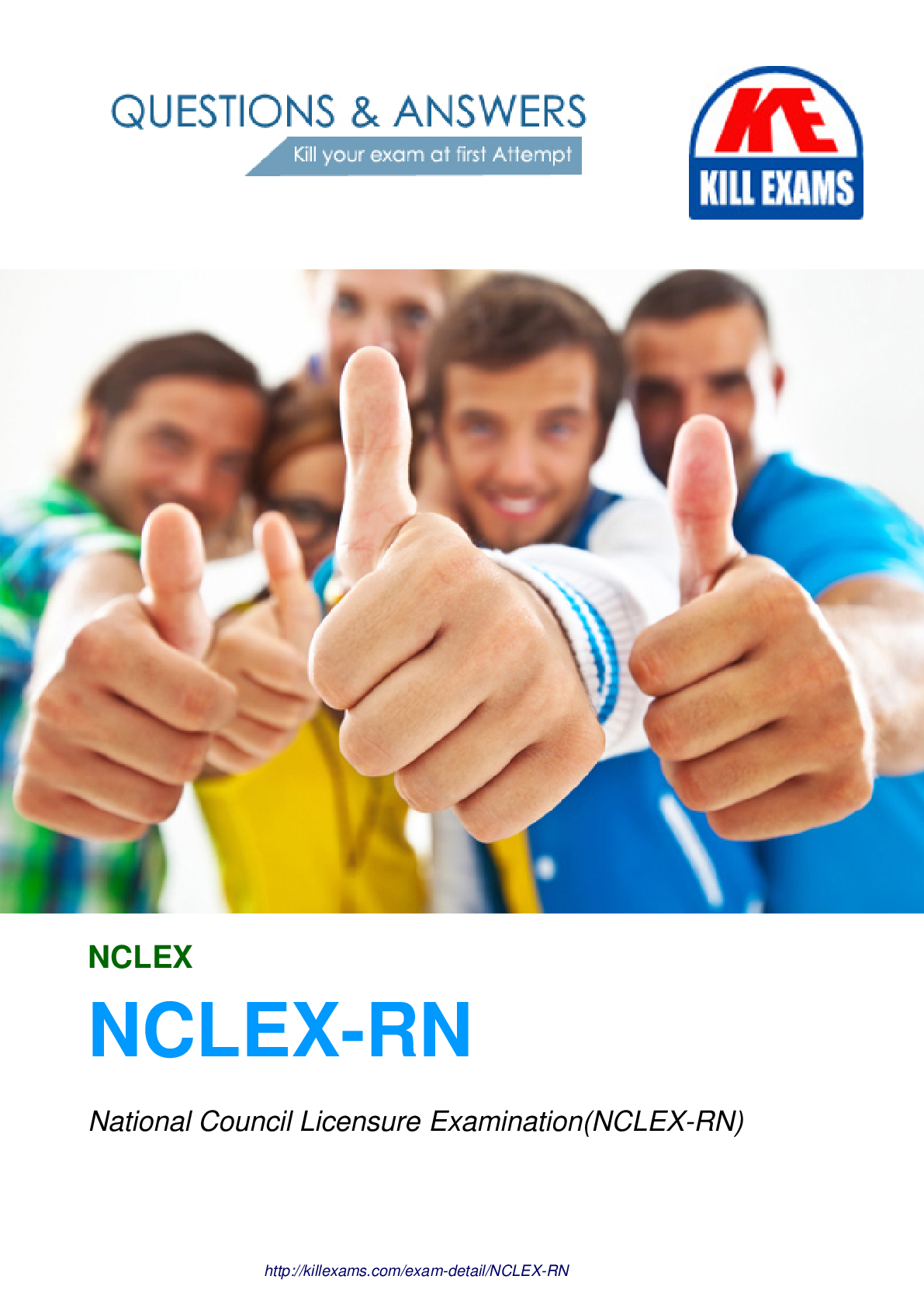
Reviews( 0 )
Document information
Connected school, study & course
About the document
Uploaded On
Aug 08, 2021
Number of pages
541
Written in
Additional information
This document has been written for:
Uploaded
Aug 08, 2021
Downloads
0
Views
50




